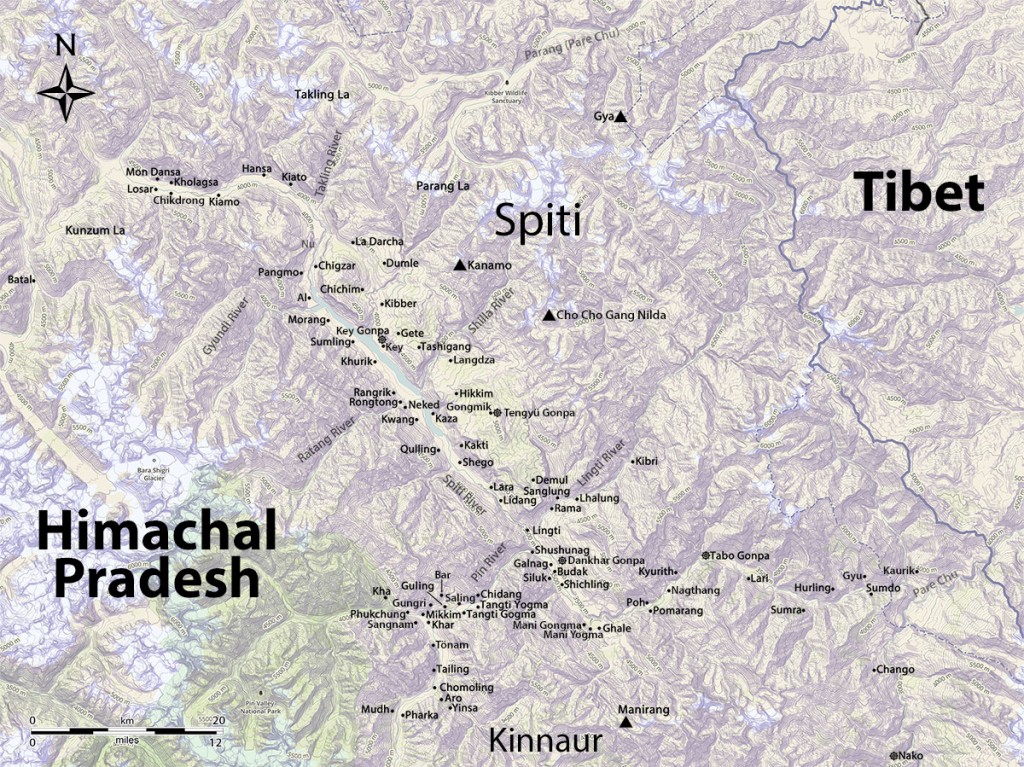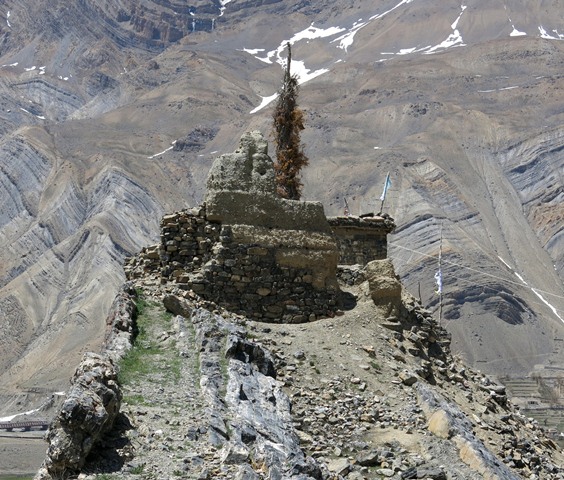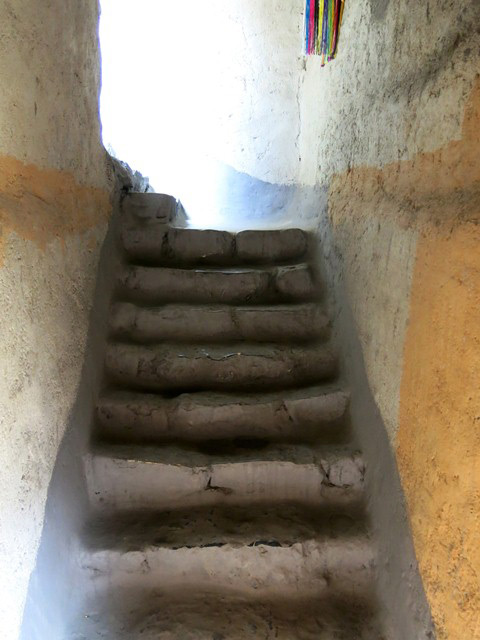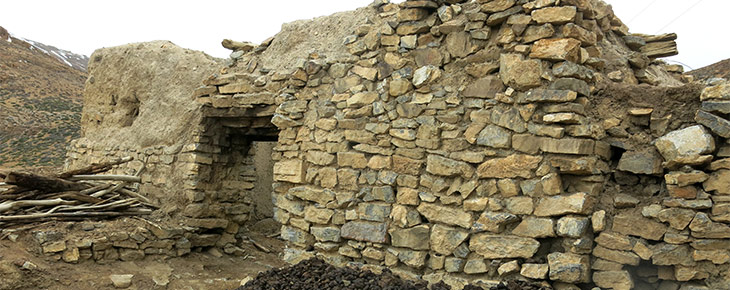
June 2015
John Vincent Bellezza
Welcome to another Flight of the Khyung and further explorations of Spiti! This issue continues with the study of the early cultural history of this enchanting region. There is also an article on the indigenous priests and spirit-mediums of Spiti compiled from interviews with them. The final article in this iewsletter features the old residential architecture of Spiti. In upcoming months, Flight of the Khyung will be dedicated to the archaeology of Spiti, offering you more unique contributions to the study of a locality ensconced in the Great Western Himalaya.
The contents of the newsletter are:
1) A Review of the Early Cultural History of Spiti – Part Two
- The root song of Spiti
- The territorial deities of Spiti
- The triumvirate of ancient ritual practitioners in Spiti
- Non-Tibetan vocabulary in the dialect of Spiti
- Conclusion
2) Interviews with Jowa, Luyar and Other Luminaries in Spiti
3) A Brief Report on the Oldest Residences of Spiti
A Review of the Early Cultural History of Spiti – Part Two
As regular readers will know, throughout my career as an archaeologist and Tibetologist, I have sought out textual, ethnographic and oral histories that illuminate the early cultural history of Tibet. I have been keen to use such evidence to interpret and analyze archaeological data that I and others have collected, particularly in Upper Tibet. Although the earliest Tibetan literature goes back to just the 7th or 8th century CE, some of the myths, legends, rituals and customs contained in it purport to deal with a more distant era, as part of a widely shared cultural heritage of great persistence.
I have compared the contents of Early Historic period (630–1000 CE) Tibetan literature with later textual accounts and ethnographic phenomena to expand the scope of historical continuities that are at least 1000 years old. That some of these accounts deal with materials likely to have originated in the pre-7th century CE remains difficult to prove, except where archaeological evidence serves as independent corroboration.
A dramatic example of archaeological corroboration pertains to the horned eagle (khyung), described in many different Tibetan textual and oral sources. The horned eagle is characterized as a divine figure known long before the arrival of Buddhism in Tibet. This degree of antiquity has been verified by the discovery of a number of horned raptors in the prehistoric rock art of Upper Tibet (see January 2012, January 2013 and January 2015 Flight of the Khyung). I will also be examining stunning examples of prehistoric khyung rock art from Spiti in next month’s newsletter.
Leaving aside the archaeology of Spiti until next month, I will now review several prominent cultural features of the region that appear to be of considerable temporal depth. The old cultural traditions explored here resonate strongly with those of Upper Tibet and Ladakh, indicating that cultic, ideological and customary ties between these regions extend beyond the 10th century CE.
Keeping in mind the inherent obstacles in accurately dating the origins of ethnographic phenomena, I shall present select examples from Spiti that have an archaic or old-fashioned character, those traditions, customs and observances that are non-Buddhist in origin and comparable with the contents of early Tibetan texts and ancient materials from other cultures.
4. The root song of Spiti
I begin this presentation of relict cultural materials from Spiti with a song of just ten lines collected in the upper Spiti (Spi-ti stod) village of Hansa (Han-se) from its resident doctor (Em-chi), Tshering Thubten (Tshe-ring thub-btsan; around sixty years of age). Tshering Thubten of the Lönchenpa (Blon-chen-pa) clan is the hereditary village doctor; his father and grandfather were also doctors. This profession is only open to those from khangchen (major landowning) households. In Spiti doctors are traditionally called lharje (lha-rje / lha-rje-pa), an honorific term with ancient roots (in contrast to Em-chi, which can probably be attributed to the Mongol occupation of Tibet in the 13th century CE). It is said that the title lharje was first conferred on the court physician of King Trisong Deutsen (Khri-srong lde-u-btsan; late 8th century CE; Das 1902: 1333).*
In addition to the healing activities of Tshering Thubten and his father (Lha-rje Lha-bu tshe-ring, died in 1993, in his seventies) and grandfather (Lha-rje Tshe-ring bkra-shis lha-bu),* these men were responsible for recording the songs of Hansa, a precious documentation now that singers are disappearing in Spiti due to modernization and a reduction in communal celebrations. Literate in Tibetan, theirs is one of the only collections of Spiti songs that have been written down. I understand that more recent efforts have been made to record Spitian songs using the Devanagari and Roman alphabets (such as those by Pema Dorje in Kaza), but at best these efforts yield a phonetic equivalent of the words, not their meanings. Tshering Thubten generously showed me his song collection transcribed into notebooks, British Raj legal ledgers and booklets with folios said to have been handmade in Spiti. The oldest of these documents is at least 100–150 years old (and may actually predate the time of Tshering Thubten’s grandfather).†
According to Tshering Thubten, the traditional appellation lhabu (lha-bu; ‘son of the god’) was conferred on his ancestors because of their high social status and competence. As is well known, in Classical Tibetan historical texts, lhabu and lhase (lha-sras; ‘son of the god’) formed part of the names of Tibetan kings and ministers of the Protohistoric period (100 BCE–630 CE) and Imperial period (630–850 CE). These terms indicate a genetic relationship between the kings and ministers and the lines of deities from which they are believed to have descended. The feminine form of the word is lha-sman (Bellezza 2013: 93). A related ancient term is lheu (lhe’u; ‘little god’ and lhe’u-sman; ‘little goddess’), which is also employed to indicate kinship relations between human luminaries and the deities from which they originated (ibid., 17, 25, 33). Between 2001 and 2003, Veronika Hein (2007: 236–240) reports collecting around ninety songs in upper Kinnaur and Spiti, which she divides into nine thematic categories. It is stated that they were transcribed in the field using the International Phonetic Alphabet (IPA). In her fine preliminary study, Hein (ibid., 239) notes that wedding songs in manuscript form do exist in – different villages of Spiti. The author (ibid.) furnishes the translations of several songs, but does not include the Tibetan text. Transcribing songs using the IPA can reproduce the sounds of the words in the Spiti dialect but it does not convey their meaning and import, which of course is crucial to a cultural historical study of songs. Hein (ibid., 235) helpfully cites other studies of songs in Greater Western Tibet (upper Lahul, upper Kinnaur, Spiti, Ladakh, Zanskar, Baltistan and western Tibet). On Spitian songs, also see Tobdan 2015b, pp. 190–193.By all local accounts, the tradition of songs in Spiti is very rich. Increasingly, however, it is only through written versions that their historical and cultural significance can be properly assessed. According to Tshering Thubten, the corpus of songs in Spiti contains a lot of archaic vocabulary and cultural traditions. As an example, he cites a type of royal turban worn in ancient Spiti called umurthö (dbu mur-thod). Another example is the word reso (re-so), which means variegated, as in the black and white pulse in Tibetan medicine or the black and white of braided cords. In this vein it is worth mentioning the shun, a Spiti dance form where male and females form two halves of a circle and move around in stately steps, arms interlinked. Also found in agrarian western Tibet, the shun is of Zhang Zhung origins, or so maintains the Yungdrung Bon tradition.*
According to the famous 12th century CE Buddhist history, Me tog snying po sbrang rtsi’i bcud, by Nyang Rel Nyima Ozer (Nyang-ral nyi-ma ’od-zer (1124–1192?), the shon (sic) began during the reign of Tibet’s first king, Nyatri Tsenpo (gNya’-khri btsan-po; traditionally dated to circa 150 BCE; Bellezza 2005: 184 [n. 24]). While this conventional account of the beginnings of civilization in Tibet should not be taken literally, it does point to the ancient origin of the shun. For a description of six types of dances in Spiti including the shun, see Bajpai 2000, pp. 64, 65.Among the songs that Tshering Thubten has recorded is a major cycle for weddings (bag-len), the eighty nyalu (gnya’-glu brgyad-bcu). The root song (glu yi rtsa-ba) of the nyalu consists of just ten lines. It is entitled Shripai Nyarab Kyi Zhunglu (Srid-pa’i gna’-rabs kyi gzhung glu; Chief Song of Ancient Existence). Tshering Thubten holds that this is one of the oldest songs in Spiti and is fundamental in scope because it acts as a basis for others sung by kangchen households. This kind of ‘charter’ song is also called dangpoi lu (dang-po’i glu; first song / primary song / primal song).* Marriages aside, Tshering Thubten reports that the Chief Song of Ancient Existence can be sung at any kind of occasion, including in times of duress or trouble, whenever healing and succor are needed.
Hein (2007: 236) characterizes dang-po’i glu as ‘songs dating from previous periods’, hardly capturing the significance of this important expression. Dang-po is a cornerstone concept in indigenous Tibetan cosmogonies. It denotes the very beginning or source of existence or pinpoints the origins of a lineage or tradition. The earliest reference I have found to dang-po is in the Old Tibetan funerary ritual text Sha ru shul ston rabs: “In primitive ancient times, the primordium in the primal age” (gna’ dang po // gzhe (C.T. = ye) thog ma’ (C.T. = ma; Bellezza 2013: 197).The Chief Song of Ancient Existence begins by invoking the sun, moon and constellations of the firmament. In many archaic origins myths of Tibet, the sky or space functions as a nexus of creation and ultimate source of human culture and traditions. Similarly, the second line of the song also reveals cosmogonic imagery, calling upon the ‘upper snow’ (kha-stod). This expression does not merely refer to the snow and ice of mountains but symbolizes a primal condition or agent of existence. The use of kha in this manner can be traced to the Old Tibetan text Pt 1060, which describes the origins of the doma (do-ma), the horses believed to transport the souls of the death to the afterlife in the archaic funerary rites of Tibet (Bellezza 2013: 44 [n. 65]). There are also three geographic entities in the Chief Song of Ancient Existence to which the adjective ‘upper’ (stod) has been appended. This word has connotations of the ‘first’, ‘best’ and ‘highest’.
Each line of the Chief Song of Ancient Existence contains three interrelated subjects or motifs and ends with explicit mention of this numerical arrangement. The thirty subjects expressed in the song in total recapitulate the basic constructs of existence (srid-pa), a three-tiered circular expanse consisting of the heavens, earth and waters / underworld. Each tier of the universe is characterized by certain kinds of majestic creatures. The divine lion, lammergeyer and stag found in the second to fourth lines of the root song are related to drabla (dgra-bla), patron spirits of warriors and protectors of the people and their culture and interests. As we shall further see, the drabla still play an important role in the religious and secular traditions of Spiti.*
Tucci (1966: 61–66) provides an articulate and insightful description and analysis of songs for the dgra-lha (sic) sung in the village of Poo (sPu), in upper Kinnaur. According to Tucci, these songs preserve a good deal of “aboriginal beliefs and rituals”, which were accepted by Buddhism after giving them a “Buddhist turn”. We can indeed presuppose that these songs as well as many other customs and traditions of ancient Spiti and upper Kinnaur were altered by the Buddhist world view, ethical considerations, sensibilities and esthetics. Tucci (ibid.) reports that the dgra-lha songs were sung at the Dralang (sGra-lang) festival in the dokra (dog-ra) pad, which was viewed as the axis mundi and the projection of the four quarters of the universe. The dgra-lha belong to the lha-lnga (’go-ba’i lha-lnga), or five types of personal deities born at the same time as each human being (lhan-cig skyes). On the simultaneously arising humans, deities and demons, see Bellezza 2014, pp. 199–201. Tucci (ibid.) notes that in the dgra-lha songs of Poo, the dgra-lha and corresponding lha, gnyan and klu occupy the three vertical spheres of existence, remnants of an earlier belief system. In these songs the earth goddess (dog-mo) on each stage of an epic journey encounters a facilitator: sun and moon to the heavens, white lioness to the snowy peaks, lama to the monasteries, big man to the castle, father and mother to the house, etc. Hein (2007: 240–242) observes that the division of the world into three vertical realms and the subject matter that facilitates the earth goddess’ journey in the dgra-lha songs recorded by Tucci are fundamental structuring principles of many songs in Spiti and upper Kinnaur. Tucci (ibid., 115–119) also describes markers or registers known as tho, with different themes and numerical arrangements, which figure in the nuptial rituals of Spiti. Tho of various kinds are found in the archaeological record of Upper Tibet and in Old Tibetan ritual literature.The fifth to eighth lines of the Chief Song of Ancient Existence turn to bastions of Spiti culture and social interaction, beginning with its monasteries and monks, continuing with the castles and courts of the rulers, the home and family, and the place were the songs and dances are performed. This sacred location is called dunra (’dun-ra), an Old Tibetan word that refers to a formal place of assembly. It is in the dunra where the people meet and share with one another the gift of songs and dances, which encapsulate their world view, religious aspirations, customs and traditions, and sense of oneness as a people. Although the structure and content of the Chief Song of Ancient Existence is clearly ancient, it was modified at some point in time by giving Buddhist institutions pride of place in society. This concession is liable to go back to the 11th century CE and the establishment of Buddhist temples and secular authority in Spiti. It is not uncommon for Tibetan archaic songs and liturgies to be modified in this way by grafting onto them a paean to Buddhism and/or an oath of allegiance to the primary masters of the religion.
The ninth and tenth lines of the Chief Song of Ancient Existence revert to visions of the natural world and the sacred creatures that inhabit it. By placing this kind of content at the end of the song, the material dealing with culture and society is bracketed by the protective forces that envelop the universe. The last two lines of the song contain natural imagery (the high lakes and wild ass) associated with the high plateau of the Changthang. While Spiti is a strongly agrarian region, it has been profoundly affected by the high plateau, traditionally a source of wool, soda, salt and animal products for trade.* Lines of communications bringing both invaders and religious persons have passed through the Changthang into Spiti for many centuries as well. But the connection to the high plateau is even more fundamental than that. As we shall see in the rock art record next month, cultural influences emanating from the steppes and Upper Tibet reached Spiti in the Iron Age.
Large herds of livestock are not customarily kept in Spiti because of high snowfall and the difficulties in feeding them in these conditions. This was noted by Diack (1899: 106) and by contemporary Spitians to whom I spoke. For a review of commodities traded between Tibet and Himachal Pradesh in the British Raj period, See Thakur 2001, pp. 11–13.According to Tshering Thubten, each of the ten lines of the Chief Song of Ancient Existence is the theme of an entire song of the nyalu marriage cycle, a decimal set of allusions and metaphors that expounds upon the charter of Spiti culture. A septisyllabic meter is commonly employed in Tibetan poetry, hymns and liturgies, as it is in our song:
The vault of the heavens, the sun and moon, the constellations, these three.
The upper snows, the lion, the turquoise mane, these three.
The upper rock formation, the king of birds (lammergeyer), wings spread in flight, these three.
The broad meadow, the deer, the antlers, these three.
The origins of the Buddhist monastery, the rise [of Buddhism], the monks and nuns, these three.
The castle, the great men, the law court, these three.
The noble house, the mother and father, the wealth of children, these three.
The meeting place, the youthful friends, the songs and dances, these three.
The upper lake, the little fish, the golden eye, these three.
The upper plain, the little wild ass, the white mouth, these three.
Gung thang nyi zla rgyu skar gsum /
Kha stod seng ge g.yu ral gsum /
Brag stod bya rgyal gshog rtse gsum /
Spang thang sha ba rwa co gsum /
Dgon ’byung yar ’greng grwa btsun gsum /
Sku mkhar mi chen khrims ra gsum /
Dpal khang yab yum bu nor gsum /
’dun ra gzhon grogs glu gar gsum /
Mtsho stod nya chung gser mig gsum /
Thang stod rkyang chung kha dkar gsum /
In the dgra-lha cycle of songs recorded by Tucci (1966: 93, 94) in Poo, there is an interval comprised of nine lines of blessings with motifs remarkably similar to those found in the Chief Song of Ancient Existence: 1) sky, sun and moon; 2) lion of the snow mountain; 3) slate and snowy mountains; 4) stag and meadow; 5) fish and golden eye; 6) monk and hermitage; 7) castle and big man; 8) house and mother and father; 9) gathering of young men and women at the dancing pad.
The structural similarities between these two songs are no mere coincidence; they suggest that prior to the spread of Buddhism, upper Kinnaur and Spiti held certain cultural traditions in common. This net of pre-Buddhist song tradition can be extended to encompass Upper Tibet and Ladakh. This does not mean that these regions practiced the same grand religion or a singular form of bon, as some would see it, but that seminal ideologies, customs and traditions spread over Greater Western Tibet. If Ladakh, Spiti and Upper Tibet did indeed have exactly the same religion before the advent of Buddhism, then the rock art of these respective regions, with its symbolic, mythological, cultic and magical representations, should be almost identical. This is clearly not the case. While there are many trans-regional motifs and subjects, there is also much that is unique in the rock art tableau of each region. This is indicative of a considerable degree of cultural variability, as might be expected in tribally organized societies, each with its own sense of identity, territorial expanse and particular set of economic and environmental resources.
5. The territorial deities of Spiti
In Spiti, as in other parts of the Tibetan world, the tradition of territorial protective deities is widespread and well established. Much has been written in Tibetology on these types of deities and their role in Yungdrung Bon, Buddhism and folk religion. Known as yulha / yulsa (yul-lha / yul-sa; god of the country god)* zhibdak (gzhi-bdag; owner of the place) and sometimes as sabdak (sa-bdag; owner of the ground), these spirits are believed to guard over specific locales or communities. They come in a great variety of forms and belong to many different classes of divinities. Commonly thought to have their origins in antiquity, the territorial deities have a relatively minor status in Buddhism, playing a subsidiary role in its ritual traditions.
Territorial deities are thought to protect villages and encampments from harm and to insure their prosperity. It is believed that when in accord with those who live within their ambit, a yulha will bring conducive weather and prevent natural disasters from occurring. The yulha are held responsible for the well-being and fecundity of people, livestock and crops. However, when angered through the sullying of their abodes and shrines, or when not accorded the offerings they require to maintain amicable relationships, the yulha are thought to bring misfortune upon individuals, families and even entire communities. Hail storms, avalanches, freak weather, diseases and even earthquakes are attributed to the destructive powers of the yulha. The collapse of a house or some types of sickness and bad luck are also pinned on them. Thus these genii loci are the object of a highly developed ritual tradition designed to satisfy and restore the balance between them and human beings.
The most common ritual tradition conducted for the territorial deities is propitiation (gsol-kha / bsang-gsol) and attendant gift giving (mchod-pa). Other popular rituals for the yulha include libation offerings (gser-skyems), appeasement and expiation offerings (bskang-ba / bskang-gso), harm repulsion (bzlog-pa), and the construction of model palaces and other enticements (mdos). These types of rituals are characterized by specialized liturgies, some of which are found in Old Tibetan Tibetan literature of the Early Historic period (630–1000 CE). Fumigation, lustration and the offering of incense, precious substances, edible cakes and sculptures are all popular practices in the yulha ritual tradition.
With the arrival some forty-five years ago of lamas from the Tibetan diaspora, powerful ideological forces were unleashed in Spiti. These have had the effect of revitalizing Buddhism but have also had a detrimental impact on alternative religious traditions. Having survived for centuries, indigenous or non-Buddhist aspects of the yulha tradition in Spiti are giving way to more generic concepts and praxis associated with monastic Buddhism.*
This loss of ancient aspects of Spitian culture is eloquently described by Tobdan (2015b: 42): “We observe that the ancient tradition of lha-chhos [archaic religion] is weakening gradually and yielding to Lamaism. The temples are changing their forms to monasteries, the priesthood is being taken over by the lamas and the deities are seen changing their ancient names. The three powerful deities of the past, viz. da-lha [dgra-bla], sa-bdag and yul-sa are losing their individual identity and the three names are becoming synonyms of a single deity.”Each village or group of villages in Spiti has its own yulha, which belong to a number of different classes of Tibetan deities. These spirits are considered to be of worldly status, as opposed to the enlightened gods of orthodox Buddhist persuasion. I have assembled a list of the yulha of Spiti. Obtaining the names of the various spirits was a fairly straightforward process, but obtaining accurate spellings for each of them was much more challenging. In some cases, the etymology and meaning of the names of the yulha has been lost, is open to debate or is recognizable to only a few elders. As with toponyms, some of these appellations have evolved over time to reflect changing religious ideas and sensibilities.*
Like other parts of the Tibetan cultural world, place names are changing in Spiti, reflecting more modern values and conceptions; e.g., Kyu-gling is now Skyid-gling. The altering of village names in Spiti has led to a considerable amount of confusion. For example, the village of Losar is variously spelled in Tibetan as Lo-sar (name of a flower), Lho-shar (Southeast), Blo-gsal (Lucid Mind), etc.List of Territorial Deities in Spiti:
Lower Spiti (Spi-ti gsham)
| Village | Territorial deity |
| Gyu (rGyu) | Jo sku-lha |
| Lari (La-ri) | Gangs-sman rgyal-mo |
| Tabo (Ta-po) | dMan-skyong / gNyan-po, rDo-rje chen-mo, |
| Pomarang (sPo-ma rang) | Ma-sangs mched-gsum* |
| Mani Yogma (Ma-ṇi yog-ma) and Mani Gongma (Ma-ṇi gong-ma) | gNas-gsar jo-ba / Jo-bo pe-rang |
| Po (sPo) | Dgra-bla yul-lha ring / Lha chen-po, Phugs-lha kun-la rgyung,† Klu-mo spun-gsum, Jo-mo cu-li mur-ti, Khyu dbang-ma,‡ Srung-ma rdo-rje chen-mo, Gwa-ba glang,§ Ma-sangs mched-gsum |
Central Spiti (Spi-ti shod)
| Village | Territorial deity |
| Dankhar (Brang-mkhar) | Jo-dar, rTse-bla* |
| Lithang (Li-thang) | rGod-tshang / sGo-tshang† |
| Lara (La-ra) | Shel-skyong dkar-mo |
| Kaza (dKar-mdzes) | gDong-pa-can‡ |
| Kwang (Ko-wang) | Mar-ngo mes-mes |
Pin (sPin) Valley
| Village | Territorial deity |
| Chi-thang (Phyi-thang), Tangti Yogma (Tang-ti yog-ma) and Tangti Gongma (Tang-ti gong-ma)* | Srung-ma |
| Tiling (Sti-gling) | Bcu-gsum dgra-bla† |
| Sangnam (Gsang-nams) | Nor-lha ’dzam-bha-lha |
| Saling (Sa-gling), Gungri (dGung-ri), Guling (Gu-gling) | Co-dgra-bla / Dge-bsnyen sku-lha ka-ri / Chos-lha |
| Bar (Bar) | Co-lha dkar-po |
| Khar (Mkhar) | rTse-bla |
| Tönam (sTod-nams) | Jo-dar |
| Mudh (Smud) | Srung-ma che-chung gnyis |
Lingti (Gling-ti) Valley
| All villages | Jo sku-lha |
| Lha-lung | Brag-btsan |
Upper Spiti (Spi-ti stod)
| Village | Territorial deity |
| Rangrik (Rang-rigs) | Tshe-ring mched-lnga* |
| Sumling (gSum-gling) | mDung-dmar-can |
| Khurik (Khu-rigs) | Gangs-sman rgyal-mo |
| Pangmo (sPang-mo) and Al (’Al) | Shel-le brag-dkar† |
| Hansa (Han-se), Kyomo (sKyid-mo), Kyoto (sKyid-Hrod) | Dgra-bla shag-rtse / Dgra-bla rta-thugs dkar-po |
| Losar (Lo-sar) | Sring-mo, Dbang-po brgya-byin |
| Chichong (gCig-grong) | Sring-mo |
| Chichim (dKyil-khyim) | Dam-can mgar-ba nag-po |
| Kibbar (dKyil-bar) | mDung-dmar-can, Chos-skyong ru-’go long / Chos-skyong yur-’go-long , She-ma’-nyen‡ |
| Gete (dGe-sde) | mDung-dmar-can |
| Tashigang (bKra-shis sgang) | dPe-kar rgyal-po, Jo-mo sangs-dang,§ Lang-rdza chos-skyong chen-mo (Sring-mo) |
| Langza (Lang-rdza) | Pe-kar rgyal-po, Rtsi’u dmar-po,‖ Sring-mo (A-phyi A-dkar dza-ti), bKa’-srung |
| Hikkim (Yid-khyim) | rTsi’u dmar-po, bKa’-srung |
The above enumeration of territorial deities in Spiti reveals a wide cross-section of Tibetan deities with diverse origins and pedigrees. I shall now make some preliminary comments regarding this pantheon. A clearer historical picture of these divinities will only emerge with a detailed study of the oral traditions associated with yulha in Spiti.
From the name alone, little can be said about those yulha simply called Protector (Srung-ma) and Protector of the Buddhist Teachings (bKa’-srung). These are generic appellations that could refer to any manner of deities, male or female. Perhaps further research will reveal alternative names for these territorial deities.
Those yulha that stem from archaic religious traditions make up a significant portion of the total in Spiti. Among these are the dgrabla (dgra-bla) and tsebla (rtse-bla) spirits and those who carry genealogical titles (jo, jo-bo, jo-mo, co, co-co). However, it is not known how or when these divinities were inducted into the pantheon of Spiti. If fragments of ancient liturgies and songs for these kinds of deities exist in Spiti, as they seem to, we might infer that they were part of the pre-Buddhist religious-scape of the region. It is not likely that such oral traditions, especially when accompanied by animal sacrifice, would have been imported into Spiti after the spread of Buddhism in the 11th century CE. Rather, archaic classes of spirits are probably part of the earlier cultural heritage of the region.
The drabla and tsebla are two groups of closely related spirits (cf. Stein 1972: 222). As we have seen, the drabla (and tsebla) have a martial guise and are the unabashed protectors of the interests of their petitioners. They are considered particularly useful in the acquisition of wealth, the elevation of one’s social status and in warfare. In ritual texts devoted to the dgra-bla they are often endowed with zoomorphic forms. The dgrabla are noted in a number of Old Tibetan texts (see Bellezza 2014: 171). In Upper Tibet, spirit-mediums (lha-pa / dpa’-bo) have preserved invocations to the drabla, which are decidedly ancient and non-Buddhist in character (Bellezza in press).
A well-represented group of territorial deities in Spiti carry the titles jo or co (older brother, older cousin), as a constituent element of their names. Closely related terms in the pantheon of Spitian territorial deities are jowo (jo-bo; older brother, elder male relative) and jomo (jo-mo; elder female relative). Probably also of relevance to this discussion is the term singmo (sring-mo; ‘sister’), which forms the name of two yulha in Spiti. Moreover, the yulha of Kwang has the word grandfather (mes-mes) in his name, a remnant of a kinship connection between this god and the people of his locale. In neighboring Guge, yulha are often called Grandfather (Mes-mes) and Grandmother (I-phi). All of the kinship terms noted signify ancestral or genealogical relationships between the yulha and the population. This appears to have been a common state of affairs in the Tibetan world before the influence of Buddhism became paramount. Vestiges of the tradition of identifying family and clan lineages with the native deities are still detectable in much of Tibet.
Other deities thought by Tibetans to be of pre-Buddhist or bon origins represented in Spiti include the pentad of long-life sisters (Tshe-ring mched-lnga), the mistress of mountains (Gangs-sman rgyal-mo) and the queen of the water spirits (Shel-skyong dkar-mo). It is not known when these more widely distributed types of Tibetan divinities were introduced in Spiti. I-phi sgang-sman (an alternative name for Gangs-sman rgyal-mo) is also the yulha of the village of Manam (Ma-nams / Mang-nang) in Guge (cf. Gu-ge tshe-ring rgyal-po 2005: 151), where this goddess is found in a mural of the ancient village temple.
Other gods widely distributed in Tibet known in Spiti include Dam-can mgar-ba nag-po (the divine blacksmith), Pe-kar rgyal-po / Pe-har / dPe-dkar, rTsi’u dmar-po and Beg-tse gdong-pa can, all of which are important protectors of Tibetan Buddhism (Chos-skyong).* They appear to have first come into prominence in Tibet during the Imperial period and the so-called first diffusion of Buddhism (bsTan-pa snga-dar). It is, therefore, possible that these powerful gods reached Spiti in the Imperial period, brought there by minions of the Tibetan empire, as part of a first wave of cultural Tibetanization.†
Excellent coverage of these gods is found in Nebesky-Wojkowitz 1956. Similarly, Vitali (1996: 552, 553) uses reference to the subjugation of the protectress of Zanskar (Zangs-dkar), Jomo Chencikma (Jo-mo spyan-gcig-ma) by Guru Rinpoche related in the text Zangs dkar chags tshul lo rgyus as suggestive of a first wave of Tibetanization.Likewise, the pan-Tibetan gods Dbang-po brgya-byin (Indra; a chief of the gods) and Nor-lha ’dzam-bha-lha (a famous wealth god) may have possibly reached Tibet in the Imperial period. Nonetheless, the equation of Nor-lha ’dzam-bha-lha in Spiti with Jamalu Devata may indicate that this god was not an imperial Tibetan imposition but one that spread into Spiti from cis-Himalayan regions.* Whatever the genesis of this god in Spiti, a syncretistic identity is probably indicated, comprising the zoomorphic wealth spirits (nor-lha) spirits of the Tibetan archaic tradition and an important Indic figure. It is worth considering the possibility that Indra reached Spiti as part of a pre-Imperial period infusion of Indic culture. The Zhang Zhung counterpart of this ancient chief of the gods is called Gekhö (Ge-khod). Gekhö survives in Upper Tibet as the main territorial deity of Ruthok (Ru-thog), but a god under this name has not surfaced in Spiti.
According to Handa (2001: 103–107), the cult of Jamalu Devata was important in the Sena kingdom. Snellgrove (1957: 176) reports that this god (Jam-la; sic) is regarded as one of the main local deities of Spiti, as is Kyepang in Lahul and Purgyal in Kinnaur. This god (Jamlu; sic), the protector of Malana in the Kullu valley, is specifically identified with the territorial god of Hansa, Drabla Shaktse (Dra-bla shag-rtse; Tobdan 2015b: 41, 112). Tobdan (ibid., 112, 115) states that a temple for Jamlu at the foot of the Hamta pass is patronized by Spitians.Given the lack of documentary evidence, the conveyance into Spiti at a later date of territorial gods with Tibetan imperial period associations must also be entertained. Specific Buddhist figures and schools may have acted as agents of a later introduction. In the biography of Lotsawa Rinchen Sangpo, Pekar (Pe-kar), is called the ‘Goatskin Great Coat Clad’ (Ra-slag-can) and ‘Iron Cloak’ (lCags-ber) and by the Zhang Zhung name Bi-na-ya-ka, the king of the obstructors (bgegs kyi rgyal-po), he was made the protector of all the Buddhist temples in Rongchung (area abutting upper Kinnaur) by the Lochen himself (for the text, see Snellgrove and Skorupski 1980: 107 [lns. 23–27]). However, this account does not tell us when Pekar might have been first introduced in Greater Western Tibet.
The fierce red god Brag-btsan of Lhalung and mDung-dmar-can (Carrier of the Red Spear) of several other villages, with their martial overtones, appear to be ancient deities as well. The goddess She-ma’-nyen of Kibbar may have a name that originates in the Old Tibetan language. Conversely, Sanskritic elements are seen in the appellation of the yulha of Langdza, Akardzati (A-dkar dza-ti).*
A yulha in Guge with a similar Sanskritized name is Dzalamati (Dza-la-ma-ti). According to the biography of Lotsawa Rinchen Sangpo, by Khyithang Pel Yeshe, this female spirit was the junior member of an eponymous sisterhood appointed as the protectors of Buddhist temples in Guge (Snellgrove and Skorupski 1980: 93, 107 [lns. 17–23]). In the biography, each of the three elder sisters of Dzalamati retained at least part of their Zhang Zhung names (in descending birth order): Zar-na-ma (Tibetan name: sMan-’brog-mo, protector of Kha-tse’i lha-khang, sic), Dro-mur-ma (Tibetan name: bTsan-’brog-mo, protector of rGyu-lang khang-dmar) and Srog-mur-ma (Tibetan name: bDud ’brog-mo, protector of Sum-nam gyi lha-khang). The word mur-ma appears to denote ‘female water spirit’ (Tibetan = klu-mo) or another type of female elemental spirit. The Zhang Zhung word mur-ti denotes the Tibetan klu and another class of spirits called klu-btsan (Martin 2010: 172).Of special interest to a cultural-historical analysis of the yulha of Spiti is Jo-mo cu-li mur-ti of Poh. This goddess has a name with Zhang Zhung linguistic elements. Nevertheless, the only element that can be readily defined is mur-ti, which is a Zhang Zhung word for ‘spring’ or ‘water spirits’.
Native deities with names in the Zhang Zhung language(s) may have once been far more common in Spiti. However, centuries of linguistic Tibetanization have reduced evidence for this to a bare minimum.* A deity with a Zhang Zhung name that has survived in the epigraphic record is Wi Nyunyin (Wĭ-nyu-myĭn; cf. Rahula 2013) a key protectress of the Tabo monastery. This goddess, perhaps once a yulha of Tabo (cf. Klimburg-Salter 1997: 11, 12), became closely associated with the tutelary deity of Lotsawa Rinchen Sangpo, Dorje Chenmo (rDo-rje chen-mo). In her excellent book, Klimburg-Salter (ibid.) remarks that the placement of the painting of Wi Nyunyin over the doorway of the assembly hall at Tabo underscores her ancient importance.*
For photographs of murals of Wi Nyunyin and her retinue consisting of three standing female spirits, see Klimburg-Salter 1997, pp. 76, 94 (figs. 55, 56). The textile capes worn by the goddesses in these one thousand-year old paintings are longer versions of the mantle still worn by the women of Spiti. These textile mantles are called lingtse (ling-tse; a probable Zhang Zhung word) or töyok (stod-g.yogs). Some are highly colorful woolen textiles closely related to the shawl tradition of Himachal Pradesh. Others are of the Upper Tibetan style and made of felted red and green wool with appliqué designs (flowers, conjoined sun and moon, swastikas, etc.) known as drokden (sgrog-gdan). Those made from fleece are called tsharthul (tshar-thul). In Upper Tibet these mantles are generally referred to as gyabten (rgyab-rten; literally ‘back support’) but there are a number of regional names for them as well. Another ancient style of clothing in Spiti is the skin greatcoat (slag-pa), the ancient attire of bon deities and priests, according to Old Tibetan and Yungdrung Bon ritual documents. Traditionally in Spiti, they were made from sheep, goat, fox, yak calf skins. Blankets made of goat, sheep and blue sheep fleece called pu (spu) have fallen out of favor in Spiti. Diack (1899: 82) notes that in wintertime both sexes wear sheepskin greatcoats. For a generous description of the dress and ornaments of the Spitians, see Harcourt 1871, pp. 45, 46. The retinue figures of Wi Nyunyin have a blue stone in the middle of the forehead and strings of blue stones hang from the top of the head to the shoulders (ibid., 180). Stones on the head of Dorje Chenmo have been identified as turquoise and coral and the stone on her forehead as a ‘soul turquoise’ (bla-g.yu; Rahula 2013: 318). Turquoise acting as a repository (gnas) for the human soul appears to be a tradition of much antiquity in Tibet. Dorje Chenmo also wears a necklace of patterned agates (gzi) around her neck (ibid.), another ancient Tibetan material and symbolic tradition. In an illuminated manuscript from Tabo (Klimburg-Salter 1997: 218), laywomen wear the same type of jewelry as that ornamenting the circle of Wi Nyunyin. In this painting, the color, shape and texture of the blue stones clearly portrays uncut natural pieces of turquoise. Elaborate headdresses of turquoise called berak (be-rag) are still worn in Spiti, Guge and Ladakh. Turquoise is the precious stone that most epitomizes Tibetan cultures, especially in their feminine aspect. For several articles on old turquoise in Tibet, see August 2013 Flight of the Khyung.Klimburg-Salter (1997: 32) holds that inscriptions in Tabo monastery appear to mark the beginning of the Tibetanization of Spiti in the 10th to 11th century CE. Predicated on the incorporation of Spiti into the Tibetan empire, I would rather say that in linguistic and cultural terms, the inscriptions at Tabo mark a mature period in the Tibetanization of Spiti. Seen in this light, the goddess Wi Nyunyin betokens a vestigial religious tradition, one that would eventually die out completely. As Tucci observes (1988: 72), Tabo must have been a principal center for the spread of Buddhism in the western Himalaya championed by Lotswa Rinchen Sangpo. The text Mnga’ ris rgyal rabs calls Tabo by the epithet “ornament (rgyan) of Chokla” (Cog-la; Vitali 1996: 110), a region encompassing lower Spiti and adjacent parts of Guge, underlying its religious importance.
6. The triumvirate of ancient ritual practitioners in Spiti
The territorial deities of Spiti are central to an indigenous religious institution that has functioned for centuries. This village-based institution involves a trio of religious functionaries entrusted with insuring the well-being of people and the environment. The three are the priest (jowa; jo-ba), spirit-medium (luyar; lus-g.yar) and the spirit-medium’s helper (lhami; lha-mi / lha yi mi). As late as fifty years ago, this triumvirate of practitioners was active in most villages of Spiti. Since then there has been a steep decline in their numbers, especially among the priesthood.
The most powerful and influential member of the village triumvirate is the priest or jowa, a performer of various rituals on behalf of individuals and the community. The jowa belong to a hereditary profession passed down through the paternal line. It is only open to members of the khangchen or primary landowning households. The high status of the jowa (and hereditary physicians) and the value put upon their services was reflected in the custom of villagers helping them in their fields, freeing up the jowa to carry out their professional duties.
According to the jowa of Spiti, their primary function is to aid the sick by determining the cause of disease and by applying the appropriate ritual remedies. Illnesses are usually treated through propitiation of the territorial deities (lha-gsol; bskang-gsol) and libations offerings (gser-skyems). These ritual measures are also used to ensure the prosperity of people and to protect the fertility of the land and the supply of water for irrigation. Jowa can be called upon anytime to help a distressed individual or a community hit by misfortune. The jowa also officiate at weddings (bag-ston) and the hair-cutting ceremony for infants (bing-ri). However, they do not do seem to do curative rituals for livestock.
As village priests, the jowa have a prominent place in the annual cycle of village celebrations. The main communal gatherings in Spiti in which jowa are active, include New Year (Lo-gsar), a celebration near the beginning of the lunar new year (mDa’-chang), the spring irrigation festival (Zhing-smos) and the harvest festival (Nam-rgan). It is the jowa (and emchi) who determine auspicious days for agricultural activities, marriage and the starting of communal work projects (cf. Tashi Tsering and Ishimura 2012: 9).
The jowa also make horoscopes for the dead (gshin-rtsis), in order to determine the best ways of disposing of a corpse and the kinds of funerary rites that should be conducted. They oversee the proceedings of trance ceremonies and orchestrate its ritual functions. Jowa also act as interpreters between the deities possessing mediums and the wider community. During trance ceremonies these deities are consulted to ascertain the course of ritual action that the priest should pursue.
The term jowa has honorific connotations, with the word jo meaning ‘master’, ‘lord’ or ‘dignitary’, as well as denoting elder brothers and cousins. More significantly, the word jo / co has divine connotations, referring to deities that have kinship relations with humans. The particle wa (ba) is an affix that denotes the possessor or doer. Thus the word jowa might be defined as ‘agent of the ancestral god’ or something to that effect.
The old history of the jowa is not well preserved in Spiti. There does not appear to be any extant indigenous origins myths furnishing precedents for this priestly profession. In contemporary Spiti, jowa attribute their tradition to the tantric Buddhist wonderworker of the 8th century CE, Guru Rinpoche. For the jowa, Guru Rinpoche is the archetypal practitioner, the source of their legitimacy and authority. The jowa of Spiti consider themselves lay Buddhist practitioners or ngakpa (sngags-pa), allying themselves with ritualists of the same name throughout Tibet. In greater Tibet, ngakpa practice a huge variety of rituals, magic, devotions and meditative disciplines. By identifying themselves as ngakpa, the jowa of Spiti diminish the archaic religious character of their profession.
Many jowa wear a hat modeled on that of Guru Rinpoche (pad-zhwa), which may be ornamented with a crossed double thunderbolt (rdo-rje rgya-gram) and a thunderbolt finial (rdo-rje thog). Until quite recently, they also wore white turbans, an ancient style of headgear. Mentioned in Old Tibetan and Yundgrung Bon texts, this kind of turban is known as the lhathö (lha-thod), thökar (thod-dkar) or kharthö (dkar-thod), the prototypical head covering of the shen (gshen) and bon priests of yore.* The jowa are typically enrobed in the dress of a Buddhist lay practitioner, the yokma (g.yogs-ma), an upper red and white garment and a red skirt. Nowadays some jowa carry out their duties in lay clothing. The contemporary jowa of Spiti mostly practice standard Buddhist rituals relying on Tibetan texts widely available. It is uncertain if local texts preserving more ancient forms of religion are still being read.
In an Old Tibetan text of the Dunhuang collections, ITJ 734, we read: “On the white sunny side of the mountain gathered the 100 white-turbaned male gshen, who conducted the divination (mo-bthab) and performed the prognosis (pya-blhags)” (Bellezza 2008: 227).The jowa do not customarily participate in monastic functions. Although some of the religious functions of the jowa and monks overlap, they have separate orbits of activity. Each of these practitioners belongs to an autonomous, self-sustaining vocation. This separation of duties and responsibilities seems to largely account for the survival of the jowa as sacrificial priests until the late 20th century.* While all Spitians profess the Buddhist faith, clerics and laymen effectively preserve different strands of Spiti’s religious and cultural history. In function and status, jowa of the Nyingma sect seem to be the most assimilated because lay practitioners are an integral part of its ecclesiastic structure. The assimilation of the jowa into the Buddhist fold is an ongoing process. It is likely to have begun in the 11th century CE with the intense missionary activities of figures like Lotsawa Richen Sangpo.†
It is reported that the main purpose of animal sacrifice in Spiti was to appease territorial deities and demons believed to cause illness and misfortune. The main proponents of the ban on animal sacrifice were the Dalai Lama, Trijang Rinpoche (Khri-sbyang rin-po-che), Serkong Tsenshap (gSer-kong mtshan-zhabs) and Ngor Khangsar Khenchen (Ngor Khang-gsar mkhan-chen; cf. Tashi Tsering and Ishimura 2012: 8). My assessment is in line with the opinion of Tsering Dorje (Tshe-ring rdo-je), the renowned Lahuli scholar. Tsering Dorje holds that the jowa were originally bon priests who were incorporated into Buddhism as tantric ritualists (Tashi Tsering and Ishimura 2012: 10).As the primary dispenser of ritual obligations pertaining to the territorial deities in each village, the jowa are of ancient origins. This is borne out by a comparative study of village priests in western Tibet and other Himalayan regions. The historical transformation from a priest conducting archaic rites to lay Buddhist practitioners of a rather generic stripe reflects the overall cultural and religious development of Spiti. We might therefore expect that antetypes of the jowa and the other two members of the triumvirate of village religious functionaries were active in the Early Historic period (630–1000 CE) and perhaps even in the time of Zhang Zhung. The directing of the spirit-mediums by the jowa, their covenant with the territorial deities, and the priestly role in marriage, infant hair-cutting ceremonies, funerals and secular festivals all point to a formative cultural source.
Counterparts to the sacerdotal vocation of jowa are found in other parts of the Tibetan world on both sides of the Himalaya. Equivalents of the jowa still exist in Upper Tibet, upper Central Tibet, Nepal and Bhutan. This is a very diverse sacerdotal tradition, ranging from practices that are localized and archaic to those that have been heavily assimilated into Buddhism. The customs and traditions of the village priests in the Himalaya and Tibet are highly complex in scope. In this article, I will just touch upon a few notable examples, in order to highlight commonalities among the practices of these priests. Aspects of this common patrimony allude to interrelated cultural and historical origins, a topic beyond the purview of the present study.
The tradition of jowa in southern Guge (Gu-ge lho-smad) closely matches that in Spiti. The Guge jowa conducted rituals to cure sick people, exorcize demons, prevent natural disasters, and ensure the prosperity and concord of communities, precisely their functions in Spiti.* Moreover, they performed a similar set of rituals using the same type of ritual implements. The jowa of Tshorub (Tsho-rub / Tsho-srib) operated just over the border from Spiti. The most powerful jowa in Guge (traditionally 13 in number) were the priests from the village of Riti (Ri-lti / Ri-khri), who were responsible for the ritual protection of the Gu-ge royal family in the first half of the 2nd millennium CE. Later on, Rijowa (Ri-jo-ba) worked on behalf of the district leaders (rdzong-dpon).
On the jowa and Rijowa of Guge, see Gu-ge tshe-ring rgyal-po 2005, pp. 159–170. Tshe-ring rgyal-po provides an excellent account of this sacerdotal tradition, meticulously documenting customs and lore that have all but disappeared in the region.A myth explaining the origins of the jowa of Riti in Guge has survived as an oral tradition:*
“In ancient times, an aquatic mare dark in color with white fetlocks emerged from the depths of Mapham Yumtsho (Lake Manasarovar). From above the peak of Tise (Mount Kailash) a horned eagle flew down to Lake Mapham Yumtsho. These two mated and a son was born to them, a dark-colored victorious horned eagle with a white turban (rgyal-khyung ’ol-ba thod-dkar). All the inhabitants of the country were amazed by his magnificent appearance. So pleased was the king of the country with his form that he bestowed the name Garab Dorje (dGa’-rab rdo-rje; Greatly Pleasing Ritual Thunderbolt) upon this personage. Garab Dorje was the first Rijowa.”
This abridged version of the origins myth (srid-rabs) of the Rijowa was collected many years ago from the Rijowa by Tshering Choephel, an expert on the cultural history of Upper Tibet, who is based in Dharamsala. Tshering Choephel states that the Rijowa told him when fleeing Tibet in 1959 for Sumdo in Spiti, he had a horse laden with personal possessions. Unfortunately, during his exodus this horse fell off a narrow ledge and plunged into a river. Among the belongings the Rijowa lost was the history of his lineage and the texts he used to perform rituals. Other ritual texts of the Rijowa were stored in the monastery in Guge to which he was affiliated, Ri Tashi Gephel (Ri bkra-shis dge-’phel). This literature was lost when the monastery was destroyed during the Chinese Cultural Revolution.The story of the first Rijowa is clearly a syncretistic account, combining archaic and Buddhist cultural motifs to create an integral origins myth. It seems likely that such etiologic myths for the jowa of Spiti also existed, perhaps until recently. A seminal principle in the archaic cosmogonies of Tibet, as preserved in Old Tibetan and Yungdrung Bon literature, is the male sky or mountain meeting the female earth or lake to produce existence or any of its constituent parts. One of the oldest textual references to these binary agents of creation is in a funerary text entitled Sha ru shul ston rabs (written circa 900 CE), and concerns the mighty rearing up blue sky and the majestic shimmering expanse ocean (Bellezza 2013: 210; January 2014 Flight of the Khyung).
In the Rijowa origins myth, the mountain is represented by the horned eagle and the lake by the mare, animals that have long had sacred connotations in Tibet. The khyung or horned eagle is also a totem of the Khyung clan of western Tibet, Ladakh and Spiti, which is detailed in several texts (Khyung rabs). Lore about the horned eagle and horse is first recorded in Old Tibetan texts. For instance, the aquatic horse (chu-rta) is mentioned in Pt 1283 and Sha ru shul ston rabs, and it is still a vibrant figure in the mythology of Upper Tibet. The term olwa (’ol-ba) to denote the dark brown color of a horse occurs in Pt 1060, a funerary mythology text of the Imperial period (Bellezza 2013: 44 [n. 65]). The white turban (thod-dkar of the first Rijowa), symbol of sanctity and authority, is recorded in a number of Old Tibetan texts (Pt. 1285, 1286, 1290, ITJ 734, Gathang Bumpa manuscripts, etc.), as the headgear of ancestral deities, male priests (pho-gshen) and lords and kings.*
In a mural of the upper temple at Dankhar monastery (sNa-kha tshang), there are three male yulha with white complexions and white turbans brandishing bows, arrows, swords and whips, along with three female counterparts (Laurent 2014: 115, 123). Among these figures is one identified as the chief territorial god of Guge, Mebau (Mes-ba’u); they are estimated to date to the first half of the 18th century (ibid.). Laurent (ibid., 123, 124) opines that Mebau is not only a territorial protective deity but also the paternal progenitor of the people of Guge, who became conflated with the founder of the Guge dynasty, King Nyima Gön (Nyi-ma mgon). The ancestral functions of yulha and other spirits of the natural environment are well established in Tibetan culture, lending credence to Laurent’s assertions. How much of the ancient identity of the yulha as ancestral figures remained when the mural of Mebau was painted at Dankhar, however, is a moot point.The only patently Buddhist element in the Rijowa origins myth is the name of the first priest, Garab Dorje, who is also the first human teacher of the Great Perfection (rDzogs-chen), a school of mind training and mysticism. But even here there are allusions to Zhang Zhung and ancient bon tradition, for Zhang Zhung Garab is the 13th member of the Zhang Zhung nyengyü (Zhang-zhung snyan-rgyud), a protohistoric Great Perfection master, according to Yungdrung Bon. The identification of the first Rijowa with Garab Dorje greatly elevates the standing of his sacerdotal lineage, helping to explain its august place in the old society of Guge.
Among the Gurungs of Nepal, the counterpart of the jowa is the pachyu (equivalent of the Tibetan pha-jo). The pachyu and other indigenous priests of the Gurung are closely associated with a corpus of ritual traditions known as bon. According to Gurung (2003: 218–221), the pachyu is the earliest kind of Gurung priest. Gurung (ibid.) maintains that wild animal components of the dress and paraphernalia of the pachyu indicate that they originally came from an ancient hunting and gathering society. The pachyu discharge a variety of rituals for the benefit of the living and the dead (ibid.). There are also female pachyu (ibid.).
In more Tibetanized regions of Nepal like Nupri (Nub-ri), village priests specializing in rituals involving the yulha and other primitive types of spirits are called phajo (pha-jo). Nearly extinct in Nupri, they dress in white gowns and turbans, and are said by Buddhist lamas to be related to the bon priests of the Gurungs situated down valley. According to the lamas of Nupri, the activities of the phajo are called michoe (mi-chos; “tradition of men”, conveying secularized or folk traditions). For example, the phajo of Roe (Ros) village in Nupri execute healing rites for villagers and participate in propitiatory (gangs-gsol / lha-bsang) rituals conducted by local householder lamas for the territorial god Punggyen / Rigyalpo Wangpo (sPung-rgyan / Ri-rgyal-po dbang-po).* It is said that the phajo are so named because they carry our rites for the phalha (pha-lha; father god, another form of the pho-lha) of the community. In Roe these phalha are no other than the yulha and male members of his retinue. Clearly, the old term phajo has genealogical connotations pertaining to elders and paternal ancestors. In Nupri it is being altered to phachö (pha-mchod; ‘worshippers of the phalha’), reflecting a more Buddhist understanding of the priests’ functions.
In communal lha-bsang rituals for the yulha, reportedly carried out three times a year, including during the Dachang (mDa’-chang) festival, the phajo of Roe take a specially selected birch called phoshing (pho-shing; ‘father wood’) after it has gone in a procession around the village, and erect it as the mast (lha-dar) for the mountain god Punggyen (depicted in one local mural as a white figure holding a spear and jewels and mounted on a white horse). In order to purify themselves for the ritual, the phajo fumigate their body and wash their hands in milk. In the retinue of Punggyyen are seven subsidiary figures, including Yak Khampa (g.Yag-kham-pa; Tawny Yak) and Lukarpo (Lug-dkar-po; White Sheep), which are considered the pholha (pho-lha; god of males) emanations of the three lower status lineages (rgyud-pa) of Roe. In descending order, they are Pönsang (dPon-bzang), Yurkhong (Yur-khong) and Chukmin / Chungmen (Phyugs-min / Chung-dman). Traditionally, each of these three lineages had their own phajo. As of 1998, there were two left: Tshewang Tenzin (Tshe-dbang bstan-’dzin) of the Pönsang lineage and Tshering Wanggyal (Tshe-ring dbang-rgyal) of the Yurkhong lineage. The village lamas of Roe mostly belong to the highest status clan of the village, Ngadak (mNga’-bdag). Members of the Ngadak clan state that they were originally ritualists for the Tibetan emperor Trisong Deutsen (Khri-srong lde’u-btsan). It is reported that due to this historical connection to the emperor, the Ngadak inherited the famous mountain god Nyenchen Thangla (gNyan-chen thang-lha) as their personal protector (sku-lha). Thus, in Nupri parallel religious lineages endure, those more and those less associated with orthodox Buddhist practices and symbols of authority. I carried out interviews in the village of Roe in November of 1998.The occurrence of the same type of priestly tradition among the Gurungs and Tibetan tribes (called Bhotia in Nepal and India) suggests origins of considerable antiquity. Leaving aside the possibility that the tradition of phajo was grafted on to these respective cultures at a later date, it appears to stem from a remote period when the Gurungs inhabited the Tibetan plateau, as stated in their origin myths.* Another indication of the antiquity of the phajo is the existence of an eponymous clan (Phajo / Phacho) at Lake Dangra (Dang-ra g.yu-mtsho) in the central Changthang, which is said to have originated in the time of Zhang Zhung (Bellezza 2001: 19; 2008: 267).
On the mythology and rituals of the Gurung, as well as on interactions (positive and negative) between the Gurung priests and Buddhist lama, see Mumford 1990.A closely related class of village priests in Mustang, and in Nyalam (gNya’-lam) and Kyirong (sKyid-grong) in southern Tibet is the aya (A-ya). They practice divination, animal sacrifice and conducted various kinds of rituals in which territorial deities played a major part. Charles Ramble (2007), in his excellent study of this priesthood, furnishes ethnographic information on their practices and examines Tibetan literature suggesting that the aya are derived from ancient bon ritual functionaries.
In Bhutan many village priests are also called phajo. They are officiants for a ritual tradition known as lhabon (lha-bon).* Just like the jowa tradition of Spiti and Guge, the lhabon of Bhutan is centered on the territorial deities, and is comprised of healing, fortune-bestowing and apotropaic rituals. The phajo of Bhutan carry out animal sacrifice (dmar-mchod) in conjunction with invocations to the village guardian deity, as part of a suite of indigenous rituals known as lhabö (lha-’bod), which includes the designation of cattle as vehicles for the gods.† The tradition of lhabon is first documented in Tibetan texts of the Imperial period. A practitioner named Lhabon Trangzu (Lha-bon ’prang-zu) is one of several kinds of bon priests listed in Pt 734 (Bellezza 2013: 232; 2008: 437; Stein 2010: 123 [n. 12]). Classical Tibetan historical texts tell us that lhabon priests were appointed to protect the early kings of Tibet.
The phajo of Bhutan are also called lhabon. Lhabon priests are found in Sikkim and Nepal as well. For a case study of lhabon in eastern Nepal, see Diemberger 1992; for a case study in Sikkim, see Balikci 2008. Also see Ramble 2007; Diemberger and Hazod 1997. See op. cit. Dorji 2002. According to this researcher (ibid.), the original character of the calling of the village god rituals is gradually disappearing. He adds that animal sacrifices were banned in the 1980s and festivals have been heavily curtailed. This same set of observations holds true for Spiti: ever more human and financial resources pour into monastic Buddhism, to the neglect of alternative forms of religious tradition and secular communal activities.The second member of the triumvirate of village religious functionaries in Spiti is the spirit-medium, locally called luyar (literally, ‘borrowed body’). This term appropriately describes the spirit-mediums of Spiti, who serve as vehicles and mouthpieces for local territorial deities.* None of the famous mountain gods of Tibet appear to take over the bodies and minds of the Spiti spirit-mediums; their focus is the village guardian deity, irrespective of any greater significance it might have in the Tibetan world. The luyar customarily enters a trance in the presence of the jowa, who acts as a supervisor of the proceedings an interpreter of the utterances of the deity and an executor of its directives. Luyar belong to all communities in Spiti including the scheduled castes. This vocation often runs in families but there are also luyar with no family history of practicing.
The luyar of Spiti are briefly described in Bellezza 2005, pp. 28, 29.The spirit-mediums of Spiti are primarily seen as instruments for curing illness and eliminating misfortune in individuals and communities. Operating under the auspices of the jowa, they were relied upon in virtually every village of Spiti, but now their numbers are dwindling. In addition to going into trance when called upon by patients and votaries, some luyar routinely practice on the 10th, 15th and 30th day of each lunar month. The luyar customarily participate in lifecycle celebrations. At the culmination of wedding celebrations (bag-ston),* when the bride (pha-ma) is brought to the groom’s house (bag-len), a trance ceremony is held to bring harmony to the couple by reconciling their personal and territorial spirits. For protective purposes, spirit-mediums are sometimes present at the hair cutting ceremony (bing-ri), which is held when the firstborn of a family is one to two years old. Occasionally lu-yar go into trance to aid the dead. Spirit-mediums also play an important role in the communal festivities of Spiti. These include celebrations of the winter solstice (Lo-gsar), the first lunar month (mDa’-chang), springtime irrigation of the fields (Zhing-smos) and the harvest (Nam-rgan).†
For a sketch of marriage traditions in Spiti, see Bajpai 2000, pp. 58, 59. For a chart of agricultural activities and rituals, see Tashi Tsering 2014, pp. 175, 176.The origins of the spirit-mediums of Tibet and the Himalaya (and those of Central Asia, Siberia and further afield) have disappeared into the mists of prehistory. In the Yungdrung Bon tradition, spirit-mediumship is part of the first system of teachings, the Chashen (Phya-gshen) vehicle, which is attributed to very ancient times and the founder of the religion, Shenrab (gShen-rab).*
On the tradition of spirit-mediumship in Yungdrung Bon, see Bellezza 2005, pp. 344–355.For the trance ceremony, the luyar of Spiti wear cloth robes with wide sleeves and a folded skirt. Customarily, red robes are used for the red-colored spirits (including the btsan) and white robes for the white deities (including those of the chos-skyong and chos-lha classes). Similar style robes are worn by spirit-mediums and priests in sundry parts of the Himalaya and in the eastern Tibetan borderlands. In Tibet this type of dress is called jolber (’jol-ber). According to the Yungdrung Bon tradition, the jolber was worn by the bon and shen priests of Zhang Zhung and ancient Central Tibet (Bod; Bellezza 2008: 224, 238, 239, 285). An ancient invocations (gsol-kha) text describes a famous mountain god of Zhang Zhung, Pholha Shelgyung (Pho-lha shel-rgyung), as wearing a white silk jolber (ibid., 337). A brocade mantle (stod-khebs) is worn over the robe of a luyar and colored scarves are tied to it. These colored strips of cloth simulate the multi-hued consciousness of the deities.
The luyar don a peaked hat ornamented with skulls, the conjoined sun and moon, etc., and topped with a finial consisting of a ritual thunderbolt (rdo-rje). On the sides, at a somewhat lower level than the finial, are small colored flags (dar-’phru).These pennants are reminiscent of the decorated crest of Tibetan helmets worn by ancient warriors and spirits alike. Some of the spirit-mediums of Spiti tie turbans entwined with colored cloths. As noted, the turban is an ancient headgear in Tibet worn by priests, deities and royalty.
The single most important implement of the spirit-medium in Spiti is the phodrang (pho-brang), a bundle of bamboo rods approximately 50 cm in length in which a trident or spear point is inserted. This fasces is draped with white scarves and colored cloths. The phodrang is seen as the prime vessel or symbol of the god of possession. Typically, after donning his costume, the luyar sits quietly taking up the phodrang in his left hand. He silently invokes the Buddhist tutelary gods, head bowed, occasionally looking up to throw consecrated barleycorn in the air as an offering. Then the spirit-medium will grasp the phodrang in both hands, signaling that the deity of the trance is closing in. Soon thereafter the luyar will start to bob up and down, rock from side to side or wiggle around in circles, before jumping up to his feet. This signals the beginning of the possession state, which is honored by the placing of a white scarf (kha-btags) over the shoulders of the spirit-medium by an attendant (lha-mi). At this time, the purpose of the trance ceremony is formally announced by someone in attendance. The assistant of the luyar takes the phodrang and offers the possessing deity a silver ewer of sanctified water or spirits to drink.
At many trance ceremonies in Spiti beda minstrels play drums and the oboe. Once under the possession of a yulha, spirit-mediums consecrate and broadcast barleycorn, and make libations offerings with cups of locally distilled spirits, often not saying a word. The luyar bless strips of cloth by blowing and spitting on them and transfer the benedictions of the possessing deity to white scarves. The luyar make prognoses whilst in trance and sometimes utter prophecies. They intone blessings, give advice by encouraging virtuous conduct and adherence to Buddhist tradition, and will prescribe certain religious observances for those who are ill or facing serious problems. To heal and empower patients they will rotate their phodrang over their heads. During trance ceremonies spirit-mediums will dance, calling down the salubrious vitality of the territorial spirit. Those in attendance may participate by singing. The luyar also impale their cheeks and tongues with metal skewers as a show of the force of the deity possessing them, as do spirit-mediums in Amdo.
The luyar are silent for much of the trance ceremony; when they do speak to make diagnoses, offer advice or prophesize it is informally structured and in the colloquial language. They do not seem to be masters of elaborate invocations and poetic enunciations. The liturgical aspects of trance ceremonies are left to the jowa. They are in charge of the rituals of invocation and offering to the territorial deities. The luyar are simply vehicles for the deities, tools to be used for the benefit of the community. Thus, unlike the jowa, the luyar do not necessarily enjoy high social status by virtue of their work and some live in poverty. In this regard, there are many similarities with the spirit-mediums of Ladakh. The erratic and flagrant movements and practice self-mutilation of the luyar recalls the behavior of cis-Himalayan spirit-mediums in Himachal Pradesh.*
In contrast, the spirit-mediums (lha-pa / dpa’-bo) of pastoral Upper Tibet (they were fewer of them in the agrarian regions of far western Tibet) boast a highly developed oral tradition, consisting of formal liturgies and other utterances before and during the trance. Some of their liturgies are replete with archaisms such as the cult of warrior spirits (drabla), old-fashioned addresses to the deities and poetic allusions in the Old Tibetan language. The advice and prophecies of Upper Tibetan spirit-mediums have an authoritative air about them and are delivered in solemn language. They function as both vessels for the deities and as ritualists. This simpler arrangement of one individual doing two jobs can probably be attributed to the more elementary lifestyle of the herders. The Upper Tibetan spirit-mediums also tend to enjoy higher social status and more popular regard than the mediums of Spiti and Ladakh. Due to the vastness of their land and the scarcity of monasteries, Upper Tibetan spirit-mediums experienced less monastic oversight and interference in their affairs. For these same reasons, Upper Tibet’s spirit-mediums are considered highly valued members of the region’s communities. On the spirit-mediums of Upper Tibet, see Bellezza 2005; 2011b; 2012; in press.The third member of triumvirate of indigenous religious functionaries in Spiti is the lhami (lha-mi / lha yi mi), the attendant of the spirit-medium.* The lhami acts as the intermediary between the deities possessing spirit-mediums and the wider community. This term can be translated as the ‘person of the god’, a servant who assists the luyar with practical matters during the trance ceremony.
In Upper Tibet some functions of the lhami are fulfilled by the kalung (bka’-lung), but the main job of the kalung is to interpret the speech of the spirit-mediums, which can be in cryptic or hard-to-hear language.The lhami helps spirit-mediums put on and take off their ceremonial garments, which are rather cumbersome and complicated. When a luyar is ready to go into trance, it is the lhami who hands him the phodrang fasces. During the trance, the lhami offers the embodied deity sanctified water and libations, fetches the ritual implements and offering objects, and acts as an escort when the luyar moves around or dances. One of the most important functions of the lhami is to be present when the spirit-medium speaks, as a witness to his pronouncements.
7. Non-Tibetan vocabulary in the dialect of Spiti
Another source for the study of the ancient cultural history of Spiti is its language. Initial inquiries made during the Spiti Antiquities Expedition suggest that this dialect of Tibetan may have retained a vocabulary derived from Zhang Zhung language(s) as a relict linguistic trait.* However, more inquiry is needed if this proposition is to be firmly anchored in scholarly ground.
The study of non-Tibetan vocabulary in the Spiti dialect will require specialized methods of linguistic analysis to determine the nature of etymological ties with the extinct Zhang Zhung language. At this juncture, it cannot be distinguished what might actually be words passed on directly from Zhang Zhung preserved in the dialect of Spiti from words possibly borrowed at a later date from the so-called pronominalized Himalayan branch of Tibeto-Burman or West Himalayish languages of Kinnaur and Lahul (these languages appear to belong to the same linguistic group as Zhang Zhung).* I am also unable to discern words with a Zhang Zhung etymology that may have possibly entered Spiti with the introduction of the Tibetan language as part of specialized vocabularies (such as medical plants and nomenclature).
On the classification of the Kinnaur and Lahul languages in the greater scheme of Tibeto-Burman and their relationship to Zhang Zhung, see van Driem 2001a; 2001b; Haarh 1968.Linguistic evidence suggesting that a vocabulary of Zhang Zhung origins underlies the Spiti dialect remains scant. Except for a word for water, none of the terms provided below occur with the same meanings accorded them in the Spiti dialect in Zhang Zhung lexicons. Nevertheless, the collection of a much larger list of unusual and seemingly non-Tibetic words is certainly feasible and should provide the raw materials necessary for further study.
The vocabulary presented here pertains to animals, medicinal plants, agriculture, dress and household items, areas of everyday life where ancient words are perhaps most likely to have survived. My short list contains spellings indicated by local sources but these are not necessarily authoritative. As part of the vernacular, there is little tradition of writing down these words. As one can see, the spellings provided are generally devoid of the prefixes and suffixes that are affixed to radicals in Tibetan orthography.
1) Animals and Insects
Snow leopard = shen (Spiti), sa’u (Tibetan)
Sheep or goat astragalus = mug-lo (S), the-ge (T)
Bedbug = ci-ri-’a (S), ’dre-shig (T)
2) Plants
Sea buckthorn = tir-mug (S), star-bu (T)
Pit of an apricot or peach = rag-tse (S)
3) Clothing and Ornaments
Woman’s cape = ling-tse (S), rgyab-rten (T)
Sliver side ornaments on woman’s headdress = kon-ta (S)
4) Domestic objects
Pot lid = kha-tig (S), khabs-gcod (T)
Tea ladle = thum-pu (S), skyog (T)
Fire tongs = ’jab-tse (S), me-len skam-pa (T)
Key = ku-lig (S), lde-mig (T)
5) Miscellaneous
Physician = ’a-wa (S), Em-chi (T)
Adobe block = pi’u (S), sa-phag (T)
Infant hair-cutting ceremony = bing-ri (S)
In upper Spiti there is a word for water commonly used in agricultural contexts also found in Zhang Zhung and other languages of the Central and Western Himalaya: ti / sti. For example, ri-ti is water issuing from high mountains for irrigation, gnyis-ti / phyir-ti is water used in the second watering of fields, and ’dzag-ti is irrigation water overflowing on fields. Tashi Tsering (2014: 139) reports that sreg-ti, gsum-ti and bzhi-ti are the second, third and fourth annual watering days respectively.* Additionally, za-ti denotes water used for cooking and drinking.
On the significance of these terms, see Tobdan 2015b, pp. 4, 5. Tobdan (ibid.) explains the term ’dzag-ti, as the percolation of water from the main irrigation channel (ma-yur) of the primary owners of the agricultural lands to the secondary channel (sa-yur) running below it. Diack (1899: 163) also notes the phirti (phyir-ti) or shakti (sreg-ti), as the second watering is sometimes called.I will draw a few comparisons between the vocabulary supplied above and words in Manchad, Punan and Tinan, languages spoken in Lahul taken from a glossary compiled by T. S. Negi (2000). Manchad is spoken in the Chandra Bhaga (Pattan) valley, Punan in the lower Bhaga valley and Tinan in the Chandra valley. In Negi’s glossary he includes words for butterfly (premalig), broom (segdud), millipede (tsang-sang), fly (buyang), spider (rinchanbu), etc. in the Spiti dialect, which have equivalent terms in the Punan, Manchad or Tinan languages (e.g., millipede = sang sang-sang in P and rang sang-sang in M and T). However, during my limited inquiries, I was not able to confirm that these words actually exist in the Spiti dialect.
Negi also includes words such as shang-ku for wolf in his glossary, which is the same in the Spiti dialect and in the Punan, Manchad and Tinan languages. However, I am unable to determine whether this word originates in the Zhang Zhung language or is a dialectal variant of the Tibetan spyang-ku. The same can be said of the Spiti words wa-tse for fox and ke-men for wild chives: their origins in either Zhang Zhung or Tibetan are unclear to me. Many other words in Negi’s glossary are clearly Tibetan (e.g., lha-rje / larje for doctor).
Other words in the Spitian dialect thought to be particularly ancient are found in Tibetan dictionaries but this does not preclude linguistic origins in Zhang Zhung. Take the word for pot: in Spiti it is dig (sdig); in Punan, Manchad and Tinan it is also dig. According to the oral tradition of Lake Dangra, in the central Changthang, this word (pronounced deg) is of Zhang Zhung origins.*
Some other words in the dialect of Lake Dangra (Dang-ra g.yu-mtsho), one of the most easterly Tö (Stod) dialects, thought by local residents to be of Zhang Zhung origins include ho-’do (mountain pass, Tibetan: la), spo (hill, ri chung-chung) jab-ra (secret portal to a paradisiacal world, bas-sgo), bong-khen (boulder, pha-bong), se (ravine, grog-po), tig-krug (heart, snying), ku-lu (small, chung-chung). Interesting kinship terms from Lake Dangra of unknown etymology, but locally thought to be of Zhang Zhung origins, include mo-res (big sister, jo-mo), kho-reg (big brother, A-jo), bi-’dang (small boy, bu-chung), bo-’dang small girl (bu-mo chung-chung). I collected these words from elderly Yungdrung Bon residents on the east side of Lake Dangra in 1995 and 1999. Bon elders maintain that until the time of King Trisong Deutsen (Khri-srong lde’u-btsan, 755–797 CE), their ancestors spoke the Zhang Zhung language. Although this language was superseded by Tibetan, they state that a corpus of words belonging to the old language was locally preserved, not least of all because of pride in Zhang zhung and early bon traditions. It is reported that right up until the early 20th century, local elders maintained a coherent tradition of words belonging to the Zhang Zhung language. It is averred that elders who lived as recently as two generations ago could translate several hundred words from the Zhung Zhung language to modern Tibetan. However, in the last sixty years, the population has self-admittedly lost the ability to differentiate the origins of words belonging to various Tibetan dialects and those of Zhang Zhung origin. The Tö dialect of Lake Dangra is converging with other Tibetan dialects such as Horke (Hor-skad), Böke (Bod-skad) and Khamke (Khams-skad), a process amplified in the Chinese Communist period. The late Tenzin Namgyal (bsTan-’dzin rnam-rgyal), a luminary from Ombu (’Om-bu) village, told me that about 30 years ago he presented a list of around 200 words purportedly of Zhang Zhung origins to a Tshering Yudron (Tshe-ring g.Yu-sgron), a researcher from Lhasa. This woman was supposed to inform local residents about her use of the list but they never heard from her again. During my fieldwork at Lake Dangra in the 1990s, I was able to assemble a list of about 80 unusual words. Unusual words in the dialect of Lake Dangra mainly pertain to ordinary aspects of life and material culture such as farming, pastoralism, food and beverages, costumes, household articles, kinship, and geography. Additionally, the proper names of many topographical features in the region are said to be derived from the Zhang Zhung period. In Spiti there also appear to be a substantial number of Zhang Zhung language toponyms still extant.Eliminating more ambiguous words from a comparative exercise, there are still seven non-Tibetan terms in this preliminary survey, given their phonological and lexical qualities, which suggest common non-Tibetan linguistic origins. I propose that this vocabulary may possibly constitute an authentic relic derived from the Zhang Zhung language (s):
Apricot of peach pit = rag-tse (Spiti), regtsi (Punan), ragtsa (Tinan)
Bedbug / bug = ci-ri-’a (S), chare (P), cheri (T)
Water = ti (S), soti (P, T), ti (Manchad)
Ladle = thum-pu (S), thombu (P, M, T)
Pot lid = kha-tig (S), tigs (P), atig (M, T)
Key = ku-lig (S), kyulig (P), kulik (M), kulig (T)
Physician / father = ’a-wa (S), awa (P, T)
Even if the above seven terms are indeed derived from the Zhang Zhung language, this tells us little about how these words came to be as they are. The age of the three non-Tibetan languages of Lahul and what they might say about the geographic source and dissemination of the Zhang Zhung tongue is yet to be ascertained. We might speculate that as the Tibetan language spread westward it lost momentum in the upper reaches of Lahul and Kinnaur,* allowing preexisting languages related to Zhang Zhung to endure in the lower valleys of these regions (these non-Tibetic languages would go on to borrow words from both Tibetan and Indo-Aryan languages as they evolved into their present forms). Being on the Tibetan plateau, contact with the Tibetan language in Spiti was sufficiently strong enough to effectively displace the Zhang Zhung language, leaving behind only a vestigial vocabulary pertaining to common or insignificant things. As our understanding of the historical relationships between the Spiti dialect and the languages of Kinnaur and Lahul and those of Zhang Zhung are refined in the years to come, it is likely that the facility needed to test this hypothesis will be developed further.
The movement of the Tibetan language and its carriers all the way to Bharmour, on the south side of the mid-Himalaya range, in the Imperial period, is documented in an inscription discovered and partially translated by Francke (Thakur 2001: 22), which reads: Khyung po jo nu ’phags bas (= pas). I translate this as, “By the noble elder and younger brothers (jo-nu) of the Khyung-po [clan]”. Francke instead translates jo-nu as “Junior Lord”.8. Conclusion
As we have seen in this article, evidence suggesting a Tibetan presence in Spiti during the Imperial period includes its incorporation into the administrative structures of the Tibetan empire, imitation of imperial military organization in its household composition, the choice of early Tibetan Buddhist protective gods as yulha, the nature of its dialect, and Imperial period inscriptions (the subject of an upcoming newsletter).*
As we shall see in more depth in the months to follow, the archaeological evidence indicates that cultural connections between Spiti and other parts of Greater Western Tibet go back much further than the 7th century CE. These links were forged as part of a pre-Buddhist cultural and pre-Tibetic linguistic environment. In the Tibetan textual and oral records, the kingdom of Zhang Zhung and prehistoric religious traditions called bon serve to underline these early trans-regional links.
Tibetan literature also holds that the present day inhabitants of Greater Western Tibet have direct ancestral ties with some of the prehistoric population through still existing tribal lineages such as the Khyung, Mu (dMu) and Dru (Bru).
In pastoral Upper Tibet, ancient genealogical ties are vividly represented in the ‘old clans’ (rus-rnying) of the oral tradition, some of which trace themselves back to Zhang Zhung and Takzig (sTag-gzig; an ancient land northwest of Tibet). In Spiti clan structures are more ambiguous and are not as well developed as in the pastoral Changthang.* The same observation can be made for agrarian Ladakh and western Tibet: clan traditions there are generally not as well maintained as in the Changthang. Yet, even in Upper Tibet very little clan lore has endured. As for the Dro (’Bro)† and Chokro (Cog-ro), two famous clans active in Greater Western Tibet during the Imperial period, they either became extinct in Spiti or were absorbed into other clan and lineage structures.
According to Francke (1914: 47, 48, after Lyall 1875), there are six major clans (rus-pa) in Spiti. Gergan (De Rossi Filibeck 2002: 318) characterizes these kinship groups as paternal lineages (pha-spad), and in addition to the major ones, he lists around three dozen others, including five that carry the name ‘horned eagle’ (khyung). Two of the major lineages are associated with the scheduled castes: Henir / Nil-’gro-ba (musicians) and Nandu / Rum-pa (blacksmiths). For a discussion of these two non-Tibetan clans and others such as Blon-chen-pa in Dankhar village, see Laurent 2011, pp. 129–131. According to Francke (ibid.), the Henir clan probably signifies the Hensi caste of Kullu. The Dro (’Bro) clan once owned estates in lower Spiti and may possibly have been have been involved in the establishment of Buddhist temples in Tabo, Lari and Changchubling (Byang-chub gling; Klimburg-Salter 1997: 12). Founders of the Alchi (A-lci) assembly hall (’du-khang) and Sumtsek (gSum-rtseg) temple in Ladakh were descendants of the Dro clan (Orofino 1990: 174, 175).It is not clear from my preliminary inquiries how old some of the Tibetan lineages of Spiti might be. Also, it is unclear what actually constitutes a clan with its ancient ancestral and totemic functions and what constitutes more recent types of family lineages. Khyung-po is of course a major clan or tribe identified with Zhang Zhung, but when it might have entered into Spiti is unknown. Be that as it may, the depiction of horned eagles in the rock art of Spiti indicates that an acquaintance with its mythological dimensions in this region predates the 7th century CE. The same can be observed for the major clan of Namrupa (gNam-rus-pa); it is considered one of the oldest and most prominent clans at Lake Dangra and other parts of Tö (sTod), but when it arrived in Spiti is beyond our ken. The prospect that such clans are a bequeathal of pre-Buddhist times must be given serious consideration (cf. Laurent 2011: 130 [n. 19]). The major Spitian lineage called Lönchenpa (Blon-chen-pa) appears to derive its name from the ministerial occupation of its forebears, and is not a clan name per se.
Despite there being little clan lore connecting contemporary Spitians to their remote past, prominent subjects recurring in the rock art of all periods (e.g., swastikas, tiered shrines, anthropomorphs of the same type, etc.) culturally bridge the prehistoric and historic epochs. This rock art evidence is consonant with retention in Spiti of at least certain elements of the prehistoric ethnos or genome, not a total replacement of the earlier population.*
Snellgrove (1957: 170) asks the relevant question of whether the people of Zhang Zhung and even further west were already racially ‘Tibetan’ in the 7th century CE. He questions whether any group of non-Tibetan stock ever settled in any of these regions above 3000 m elevation (ibid., 171, 182).Interviews with Jowa, Luyar and other Luminaries in Spiti
Thanks to the efforts of local coordinators, on the Spiti Antiquities Expedition (May-June, 2015), I had the opportunity to conduct interviews with all of the jowa of Spiti (except the one from Dankhar). I also interviewed spirit-mediums, village doctors and other local luminaries. I heartily thank all these individuals for taking the time to talk to me and answer my many questions.
It is important to stress the preliminary nature of this study. It is based on a dozen or so interviews, none of which lasted more than three or four hours. Further ethnographic study in Spiti should prove very fruitful, as regards the ancient cultural heritage of the region.
The village of Gyu (rGyu) does not have a jowa, but it does have a ngakpa, Tshering Thobgye (Tshe-ring Thob-rgyal, aged sixty-four). He states that the yulha of Gyu, Joku Lha (Jo sku-lha), used to have a dedicated spirit-medium but there is no longer one in the village.
According to Lama Kushab (Bla-ma sku-zhabs, aged 77) of Lari, there was once a jowa for the three villages of lower Spiti (lCog-la yul-gsum: Lari, Tabo and Poh).* There is still a spirit-medium in Tabo for the yulha Dorje Chenmo (rDo-rje chen-mo) and Menkyong (dMan-skyong). I watched his predecessor perform in 1994. According to local lore, in olden times the spirit-medium of Tabo flew around on his drum. The oral tradition of Upper Tibet says the same thing about some of its ancient spirit-mediums. In Yungdrung Bon texts, sages of Zhang Zhung are also attributed with magical flight on drums (Bellezza 2008: 211, 214, 215, 219, 220). Lama Kushab states that there is a medium in Poh for the yulha Lhachenpo.
As is well known, lCog is an ancient toponym, occurring as Gug-lcog and sPi-lcog, which appear to be adjoining regions in Guge and southeastern Spiti respectively. For a discussion of this localization, see Vitali 1996, pp. 167 (n. 227), 252, 266 (n. 400), 307; Tropper 2008, pp. 40 (n. 216), 41 (n. 217). Tucci (1936: 83) claims that the people of Poh and further downstream in Spiti are linguistically Tibetan but racially different. Tucci (ibid., 93) adds that in dress and physique, the people of Lari are influenced by their proximity to northern Bashahr.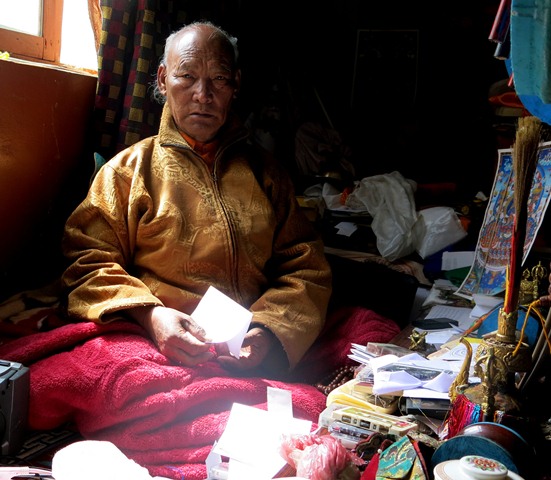
Fig. 1. Lama Orgyen, the jowa of Mani.
The jowa for the two villages of Mani (Ma-ṇi) is Lama Orgyen (Bla-ma O-rgyen, aged seventy-five). However, Lama Orgyen has lived in the administrative center of Spiti, Kaza, for around 20 years. Lama Orgyen, the father of nine children, is a quintessential householder lama of the Nyingma sect. His tutelary deity is Guru Drakpo (Gu-ru drag-po), a wrathful form of Guru Rinpoche. He relates that the word jowa belongs to the local dialect (yul-skad), the equivalent of ngakpa, a word in the language of religion (chos-skad). He adds that this type of religious practitioner varies significantly in power and effectiveness.
According to Lama Orgyen, to assist sick people, the accord between the beings of the three realms of existence (lha-mi-’dre gsum) must be maintained. He says that various worldly spirits are responsible for different kinds of disease. The water spirits (klu) cause diseases of the eyes and skin, lesions, wounds, skin discoloration, etc. The fierce red spirits (btsan) cause rib pains and goblins (rgyal-’gong) diseases of the heart and sternum. These spirits must be subdued if a patient is to recover. Lama Orgyen also says that yulha, because of their worldly status, can cause disease and must be guided and corrected by lamas, jowa and the Buddhist protective deities (chos-skyong). Lama Orgyan observes that a jowa can guide the deceased towards the best possible rebirth, preventing transformation into a ghoul (gshin-’dre), but, he says, the nature of rebirth is fundamentally related to one’s karma.
Lama Orgyan asserts that the yulha of Mani, Jowo Perang (Jo-bo pe-rang), has two brothers and a circle of 3500 spirit helpers. Jowo Perang has a white complexion with reddish highlights, a white dress and white cotton turban (ras-thod). This god holds a trident in his right hand and a skullcap full of blood in his left. Jowo Perang, like many other gods of Spiti, belongs to the chos-lha class, patrons of Buddhism (this Buddhacization of the tradition of territorial deities is still underway in Spiti). As for the old practice of animal sacrifice in Spiti, Lama Orgyan says that the yulha of Dankhar and Kibbar were particularly avid recipients until arrival there of Tibetan lamas forty or fifty years ago.
Lama Orgyen reports that spirit-mediums sometimes go into trance to find a deceased person who is wandering around lost, exhorting him or her to heed the instructions of lamas so that salvation can be obtained. When doing this kind of work, spirit-mediums declare that the possessing yulha cannot assist the dead and endorse Buddhist funerary concepts and praxis. The contact of the dead by spirit-mediums may possibly be a remnant of an ancient psychopomp tradition in Spiti, but further study is required to confirm this hypothesis. The medium of Mani is Rigdzin Namgyal (Rig-’dzin rnam-rgyal, in his 40s). Lama Orgyan affirms that when the yulha Jowo Perang is unable to help, this god through Rigdzin Namgyal refers the patient to him for other forms of ritual treatment. Lama Orgyan says that Rigdzin Namgyal’s father was also the spirit-medium of Mani, after the job passed to him with the demise of a local lineage of luyar. Lama Orgyan notes that there used to be a spirit-medium in Kaza but no longer (other sources state that this was Blo-bzang Tshul-khrims, who died around twenty years ago).* Lama Orgyan colorfully described to me how he was instrumental in turning away from animal sacrifice a water spirit (nag devata) of Lippa, in Kinnaur.
Tucci (1936: 61–63) describes a monk spirit-medium performing in the Buddhist temple at Kaza. He calls the god of the trance Chos-skyong. This appears to be an appellation for the local yulha, Dongpachen (gDong-pa-can). Tucci reports that this trance occurred at a communal festival, in order to protect human life, the well being of livestock and the fecundity of the land. Tucci observes that the spirit-medium wore sacerdotal vestments, holding a sword in one hand and taking small droughts of beer with the other, while monastic music played. Tucci writes that the medium danced frantically as an outward reflection of his battle against evil spirits. At the completion of the trance, the spirit-medium threw barleycorn on the crowd before swooning into the arms of his attendants.The jowa of Lhalung village is Mingyur Tendzin (Mi-’gyur bstan-’dzin, aged thirty-two). Mingyur Tenzin states that he comes from a long line of jowa on his paternal side. Although his father died young, his grandfather lived into his mid-eighties, passing away six or seven years ago. The tutelary god (yi-dam) of Mingyur Tenzin is Guru Drakmar (Gu-ru drag-dmar), a fierce form of Guru Rinpoche and patron of tantric rituals. In Lhalung the object of trance ceremonies is the yulha, Draktsen (Brag-btsan), a fierce spirit envisioned as holding a sword in his right hand and a phodrang in the left,* the implements of the luyar as well. Draktsen rides a white horse. The yulha of the entire the Lingti valley, Joku Lha (Jo-sku lha), does not possess mediums.† In curative rites carried out by Mingyur Dorje, he sprinkles barleycorn on patients, and employs yak horns and eagle feathers as well as more typical ritual implements of the ngakpa.‡ There is also a hereditary doctor in Lhalung.
Thukral (2006: 44) recounts the dramatic story of how this yulha was made to give up accepting the sacrifice of animals through the efforts of a figure he calls “Chokche Rinpoche” (bCo-brgyad khri-chen?). Joku Lha is propitiated by the nine villages of the Lingti valley in order to insure the supply of water for agriculture. It is said that in 2001 the villagers of Rama (Ra-ma) neglected the rituals carried out on behalf of this god and he stopped their water supply until the entire village came together to rectify the situation, but not before the entire crop was lost. See op. cit. Thukral 2006, p. 42. Thukral (ibid., 43, 44) writes that in ancient times Joku Lha used to accept the sacrifice of an eight-year old boy until a lama stopped the practice. The origins of this tale must be questioned. Tucci (1936: 74–78) describes a trance ceremony held in Lhalung so that a precious statue of the Buddha could be transferred to him. Tucci notes that that sorcerer (spirit-medium) was clad in a long white tunic and wore a head covering comprised of colorful strips of material. Tucci states that this medium held a bundle of canes bound with silk cords and tipped with an animal horn. This is of course the phodrang, the most important ritual implement of the luyar of Spiti.The jowa for eight villages of the Pin valley, the Yul Tshogye (Yul-tsho brgyad), is Chime Dorje (’Chi-med rdo-rje, in his fifties). He resides in Gungri (dGung-ri). His tutelary god is the local yulha Dge-bsnyen sku-lha ka-ri (Divine Personage Pillar Mountain with the Householder Vows). Chime Dorje says that owl wings and rhinoceros horns are used in certain rituals. He employs a piece of black bear skin on patients as a kind of veil when the ritual of the offering of cakes to the water spirits (klu-gtor) is performed.
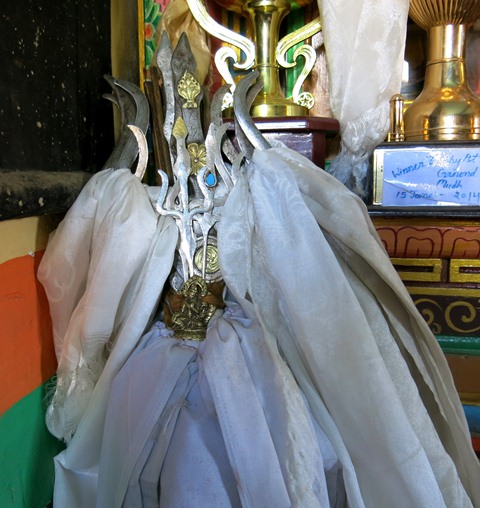
Fig. 3. The phodrang of Tsebla.
The shrine (lha-tho) and old chapel (lha-khang) of Tsebla (rTse-bla), the senior-most yulha of the Pin valley, is situated on the summit of the ruined castle in Khar (mKhar) village (cf. Tobdan 2015b: 42). This castle is called Kharteng (Mkhar-steng), which is thought to be the original nucleus of settlement in the Pin valley. There is also a new chapel in the village of Khar, where the main receptacle (a phodrang) for Tsebla is now kept. The phodrang, a kind of fasces, consists of a bundle of bamboo rods in which sliver tridents are inserted; it is draped with white scarves and colored cloths and is embellished with the brass plaque of a Buddhist deity. The spirit-medium for Tsebla, Palden Dorje (Dpal-ldan rdo-rje), opines that Kharteng is 600 or 700 years old. A foundation date for Kharteng during the time of the Guge kings may indeed be indicated on architectural grounds (more on this site in the months to come). In any case, this is a rough indication of the age of the Pin valley Tsebla. The Tsebla of Dankhar village is liable to be older than the one at Khar.*
Evidence suggesting that the fortress of Dankhar could date back as early as the 11th century CE is examined in Laurent 2010, pp. 9, 10.Perhaps ancient political rivalries were involved in the establishment of Tsebla in the Pin valley. According to the local oral tradition, the castle of Kharteng was invaded on a number of occasions by armies coming from other parts of Spiti. In order to warn the inhabitants, a fire signaling system was instituted. When attacked, the inhabitants would find refuge in Kharteng. It is said that eventually, this castle could not contain all the people of the area and they dispersed to establish other villages.
The jowa of Pin, Chime Dorje, says that Tsebla is a god that appeared at the beginning of existence (srid-pa chags-pa’i lha) before all the other gods of the Pin valley, including the more orthodox Buddhist varieties. Tsebla is known by the epithet ‘Sovereign of the World of Humans’ (’Dzam-bu’i gling gi mnga’-bdag). The spirit-medium of Tsebla, Palden Dorje, adds that this god is also called Mak gi Gurlha (dMag gi mgur-lha) because of his warrior nature and traditional role of leading the soldiers of the Pin valley into battle. Tsebla is dressed in white and rides a white horse. His hair is piled high on his head and ornamented with jewels (gtsug-gtor) and on his feet are wheels ( ’khor-lo). According to Palden Dorje, Tsebla also dons a white turban of the gods (lha-thod). Tsebla wields a sword in his right hand and the phodrang fasces in his left. This description of Tsebla is in accord with archaic iconographic traditions for yulha observed throughout the Tibetan world.
Sonam Gyatsho (Bsod-nams rgya-mtsho, aged seventy-five) of Sangnam (Gsang-nams) village, a former teacher of Tibetan language, described the main harvest festival of Pin. Called Namgen (Nam-rgan), this festival was held in Sangnam and lasted for three days. It once drew people from all over the Pin valley but in recent years it has been very much reduced in size and scope. At Namgen the spirit-medium for Tsebla would go into trance and ride a stallion, leading the ceremonies for all the yulha of the valley. The jowa would invoke the territorial deities and offer them libations, starting with Tsebla. On the second and third day of Namgen there was much singing, dancing, drinking and merriment.* Even in villages were the harvest festival of Namgen is still observed horseracing has been halted, leading to a precipitous drop in the number of horses kept in Spiti.
For a description of Namgen, see Tobdan 2015b, pp. 162–164. Harcourt (1871: 68) remarks that the Spitians are fond of horse racing, gambling and dancing.Sonam Gyatsho reports that every three years, a god called Wangpo (Dbang-po, a form of Mahadeva) would come to Sangnam via a high pass to participate in the Namgen. This god hailed from the village of Katgaon in the Bhabar valley of lower Kinnaur. Wangpo when traveling to Spiti with his party of attendants was enshrined in a sacred vase (bum-pa). Every five years Wangpo would come to Sangnam in his palanquin (rath) with a bigger circle of devotees. This god no longer visits Sangnam.
Sonam Gyatsho told me that fields were sent aside to meet the expenses of Tsebla at Namgen and other communal performances, but this tradition has been largely discontinued.* The grain from the reserved fields was used to prepare the barley beer (chang) for the festivals. Sonam Gyatsho claims that families now only contribute grain when someone is sick or in need. He also states that the yulha of Sangnam, Norlha Dzambhalha (Nor-lha ’dzam-bha-lha), is not the object of possession and that there is no medium in the village. At the winter solstice Losar (Lo-gsar) festival in Sangnam, villagers made libations offerings and festooned yaks with colored cloths and red ochre and set them free as vehicles for local spirits.†
Diack (1899: 98) notes that in many villages of Spiti one or two fields called lhazhing (lha-zhing) were attached to the local chapel (lha-khang). According to Gergan (1978: 41, 42), the Losar of ancient Zhang Zhung, extending from Mount Kailash to Dardistan, was held in mid-winter by agrarian peoples who kept careful records of the seasons. This author states that those tribes living in the Sutlej and Indus watersheds, in the general vicinity of Mount Kailash, observed Losar when the sun resumed its northern trajectory, the beginning of the auspicious half of the year (ibid., 42, 43).According to the Tsebla spirit-medium, Palden Dorje (both he and his wife come from families that have produced luyar), the medium for the yulha of Bar, Cholha Karpo (Co-lha dkar-po), is named Tsheten Gadro (Tshe-brtan dga’-spro). The spirit-mediums of Mudh (sMud) are Rigdzin Ngodrup (Rig-’dzin dngos-sgrub, in his 70s) for Sungmache (Srung-ma che) and Pema Jigme (Padma ’jigs-med, in his 40s) for Sungmachung (Srung-ma chung). The medium for Chusum Drabla (Bcu-gsum dgra-bla) of Tiling (Sti-gling) is Dorje Tsheten (rDo-rje tshe-brtan). There is now no medium for the yulha of Tönam (Stod-nams) village, Jodar (Jo-dar). The luyar for Srungma of Tangti (Tang-sti) is Gadro Dorje (Dga’-spro rdo-rje). Palden Dorje says that, in descending order of precedence, the yulha of Pin are as follows: rTse-bla, Co-lha dkar-po, bCu-gsum dgra-bla, ’Dzam-bha-lha, Smud srung-ma che-chung gnyis, Tang-sti srumg-ma.
Another notable personality I had the chance to speak to about the culture and geography of the Pin valley was the hereditary doctor of Gungri village, Choedrak Norbu (Chos-grags nor-bu). My team and I also had the pleasure of meeting Jigme Tenzin Dorje Rinpoche (’Jigs-med bstan-’dzin rdo-rje) at his lofty summer residence. He is the head lama of the Gungri monastery Orgyan Sangngak Choeling (O-rgyan gsang-sngags chos-gling). Jigme Tenzin Dorje is a married lama of the Nyingma sect, aged 50. Like some other clerics I spoke with, he expressed some ambivalence about the tradition of spirit-mediumship, at least as practiced in Spiti.
The yulha of village Kwang (Go-wang) is called Marngo Meme (Mar-ngo mes-mes; Face Downwards Protector). The name of this deity conveys that he is the protector of the Spiti river valley from Kwang downstream all the way to lower Spiti. Marngo Meme is the same god as Drabla Yulharing (Dgra-bla yul-lha ring), one of the territorial gods of Poh. This warrior spirit is also called ‘Long Country God’ (Yul-lha ring) because of the geographic extent of his protective embrace. The shrine (lha-tho) of Marngo Meme stands on a large rock jutting into the Spiti river at the main crossing point, but his chapel (lha-khang) is in Poh. Nowadays Marngo Meme is also called Choelha (Chos-lha), the protector of the bridge across the Spiti river located near his shrine. The spirit-medium for Marngo Meme is Getro Dorje (dGe-spro rdo-rje), a member of the blacksmith (bzo-pa) caste who resides in Poh. Information about Kwang came from several informants.
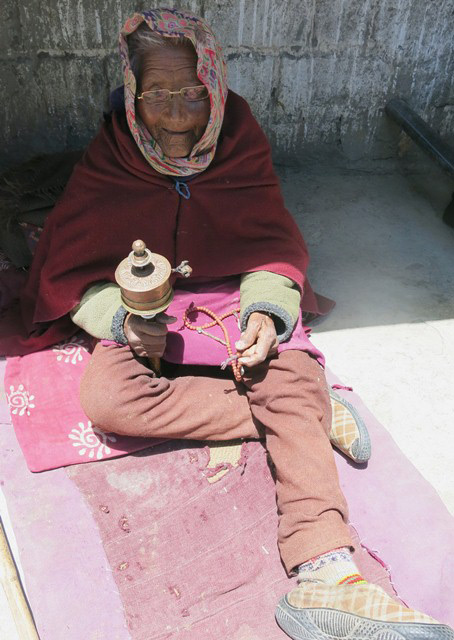
Fig. 4. Tshering Butri, aged ninety-five, saying her prayers.
According to Tshering Dondrub (Tshe-ring don-’grub, born 1935) of Rangrik (Rang-rigs), the yulha of his village, Tshering Che Nga (Tshe-ring mched-lnga; Five Long Life Sisters), is a single personality in the circle of Palden Lhamo. There is no longer a hereditary jowa, doctor or spirit-medium in Rang-rigs, the largest traditional village in Spiti (approximately 630 residents). Animal sacrifice was carried out in Rangrik until around fifty years ago when it was stopped at the behest of Trijang Rinpoche (Khri-sbyang rin-po-che), the junior tutor to the Dalai Lama. In Rangrik I also met Tshering Butri (Tshe-ring ’bu-khrid, born 1920), one of the oldest people in Spiti, as she was saying her prayers.
In the village of Khurik (Khu-rigs), I briefly interviewed Pasang Dondrub (Pa-sangs don-grub, aged 65). In this village the tradition of jowa has been discontinued. According to Tashi Phuntsok (bKra-shis phun-tshogs, aged 68), a well-informed individual from Sumling (Sum-gling), the local yulha, Dungmarchen (mDung-dmar-can) is in the circle of Namthosé (rNam-tho-sras), a famous wealth god. He says that Dungmarchen is black in color, the holder of a red spear and the rider a black horse. There is no longer a jowa in Sumling.
In the village of Hansa (Han-se), my main informant was Lharje Tshering Tashi (Lha-rje tshe-ring bkra-shis), the hereditary doctor of the village. His paternal lineage is called Pacha (dPa’-cha; Accoutrements of the Hero), which he says is one of the old genealogical groupings in Spiti. There is lineage or clan in Hansa called Jowa (Jo-ba), but no one belonging to it still practices as a jowa.
Towering above Hansa is the mountain abode of the local yulha Drabla Shaktse (Dgra-bla shag-rtse), which also serves as the main protector of the upper end of the Spiti valley. This god is also known as Sabdak Shaktse (Sa-bdag shag-rtse; Tobdan 2015b: 41). The shrine (lha-tho) for Drabla Shaktse is located next to a Buddhist retreat center, on the opposite side of valley from the village of Hansa. In the vicinity, is a trio of newly refurbished chortens for the three main bodhisattvas (Rigs-gsum mgon), which encase the remains of an older set said to have been erected by Lotsawa Rinchen Sangpo. According to Lharje Tshering, Drabla Shaktse is propitiated from Rangrik to Losar in the 8th lunar month. The text used for his propitiation in Losar and Hansa was written by 5th Dalai Lama: Gong sa lnga pa chen pos ljags bsgrigs gnang ba’i rta thugs dkar po, published by Shes-rig par-khang, Dharamsala. There is no longer jowa practicing in either Hansa or Losar.
In Losar, I spoke with Tshering Thubten (Tshe-ring thub-bstan, in his sixties) of the well known Blon-chen-pa paternal line. The yulha of Losar, Dbang-po brgya-byin (Indra) is not the object of possession traditionally. According to Tshering Thubten, Drabla Shaktse is propitiated (in a bskang-gsol ritual) by the entire village of Losar on the 10th to 12th day of the first lunar month. Drabla Shaktse is also invoked after planting and before the first watering of the fields and before harvest, which is carried out at his chapel. This god is the family protector (khyims-lha) of Tshering Thubten. An old scroll painting (thang-ka) owned by him depicts Drabla Shaktse as an all-white god, wearing a golden helmet and riding a white horse. The deity appears to be holding a horsewhip in his right hand and a lasso in his left. According to Tshering Thubten, there is a spirit-medium in the nearby village Chikdrong (Gcig-grong) for the yulha Singmo (Sring-mo), the younger sister of the goddess of the same name in Tashigang.
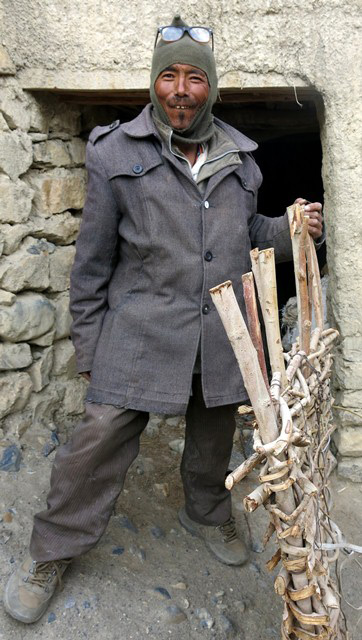
Fig. 5. Ngawang Tshering, the village doctor of Kibbar.
In Kibbar my most important source of information was Ngawang Tshering (Ngag-dbang tshe-ring, aged sixty-four), the village doctor. Ngawang Tenzin reports that the correct name of the village is Kyilbar (dKyil-bar), so called because when the sky is viewed from its rooftops it forms a circular expanse. He asserts that the oldest name for doctor (Em-chi) in Spiti is awa (’a-wa), which he differentiates from the Tibetan word for paternal uncle (’a-ba). Like another word for doctor, lharje (lha-rje) awa is an honorific term, recalling an Old Tibetan epithet for priests (gshen): father (pha).
One of the yulha of Kibbar is Choekyong Yurgolong (Chos-skyong yur-’go-long / Chos-skyong ru-’go long), a fierce red god (btsan), a special protector of irrigation water and farmland.* His shrine (lha-tho) is situated north of the village. The spirit-medium for Yurgolong in Kibbar is a member of the musician (beda) caste.
Tashi Tsering (2014: 115 [n. 99]) calls this god Yur-mgo-log (Irrigation Channel head Collapse) and states that according to local tradition, it originally came from Ladakh in the form of a raven who, when he arrived high above Kibbar, created a spring with his beak.Another territorial god of Kibbar is called Dungpachen (gDung-pa can / mDung-pa-can) or Dungmarchen (mDung-dmar-can). From information that he received from his elders, Ngawang Tshering believes that the latter spelling is the best rendering of the god’s name. It means ‘Holder of the Red Spear’. Dungmarchen is a white god thought to be of ancient origins. His shrine is situated southeast of the village, however, his chapel is located near the proximate village of Gede (dGe-sde), at a place called Dungpachen Drak (mDung-pa-can brag). This yulha is itinerant and is thought to travel to India (lower reaches of Himachal Pradesh) for the winter. According to Ngawang Tshering, Dungmarchen departs on the 17th day of the 10th lunar month and returns to Spiti on the 8th day of the 1st month.
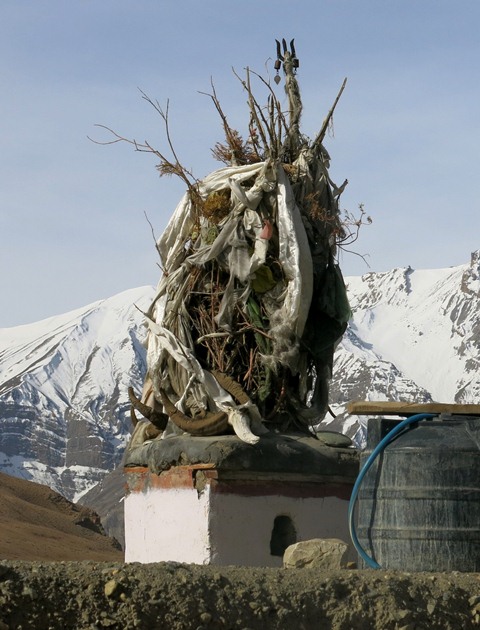
Fig. 6. A shrine for the god Dungmarchen on the rooftop of a house, Kibbar.
According to Ngawang Tshering, to see Dungmarchen off (skyel-ma) and to receive him (bsun-ma), a propitiation ritual (lha-gsol) is performed. There are two homes in Kibbar with special shrines (lha-tho) on the roof for Dungmarchen. These families have a special relationship with this god and the senior male member from each (rDo-rje rnam-rgyal and Padma ’dre-’dul) leads the propitiation ritual. It is said that a warrior spirit (dgra-lha), a friend of Dungmarchen, presides over the propitiation of the god. This ritual includes the preparation of livestock used as the mounts of the god. These divine yaks (lha-g.yag), goats (lha-ra), horses (lha-rta) and sheep (lha-lung) are festooned with cloths of five different colors (dar-sna-lnga). Butter is applied to the horns and their backs are decorated with red ochre. This appears to be one of the best-preserved examples of gifting animals to the yulha still practiced in Spiti, an ancient custom well attested in Upper Tibet.* When the god Dungmarchen goes to India, juniper boughs are also added to the mast (dar-lcog) at his shrine.
On this custom in Upper Tibet, see Bellezza 2005, pp. 131, 132, 467–483; 2008, pp. 454, 455.The third yulha of Kibbar is Shemanyen (She-ma’-nyen), a female water spirit (klu-mo). Ngawang Tshering says that until he was around ten years of age there was a spirit-medium for this deity named Iphi Tshering Kyidzom (I-phi tshe-ring skyid-’dzoms), who passed away in her seventies. The shrine for Shemanyen is situated east of the village. Ngawang Tshering observes that places with shrines and chapels for territorial gods are called labra (lab-ra; related to the word lab-rtse, piles of stones and other types of shrines).
The three yulha of Kibbar play important roles in the village by insuring the water supply for farming and by controlling the distribution of irrigation water. Each yulha oversees one of the three agricultural sectors of Kibbar. They are Hara (Ha-ra): Yurgolong, Pi-dzur (Pi-dzur): Dungmarchen, and Shirik (Shi-rigs): Shemanyen. Those in charge of allocating irrigation water are called yurpön (yur-dpon), a revolving position among khangchen households.*
Tashi Tsering (2014: 130): yur-mgo-pa. This position is open to women (ibid.). For a brief description of their functions, see ibid., pp. 136, 137.At New Year, the three yulha of Kibbar are propitiated for good fortune and well being. They are also called upon during key agricultural operations. Ngawang Tshering notes that these rituals are carried out by monks but laymen can also do them. He states that standard versions of these rituals predominate, such as those for the eight classes of Buddhist spirits (lha-srin sde-brgyad). For example, to insure that there will be a sufficient supply of irrigation water, invocations (gsol-kha) and libations (gser-skyems) rituals are held at the shrine of Dungmarchen when he returns from India.*
Also, on 25th day of first lunar month a ceremony to propitiate the water spirits (klu-gtor) is held. Woman of khangchen households perform a ceremony called Chutsek (Chu-rtseg) at water sources, which used to include the wearing of traditional attire, singing and dancing. There are also special rituals to cure those who become sick because of the water spirits and sovereigns of the soil: klu yi gdon drol (= ’grol) and sa-thag (= bdag) gdon-drol (= ’grol). See op. cit. Tashi Tsering 2014, pp. 131, 132, 148.Ngawang Tshering states that, on the third day of the first lunar month, a festival known as Dachang (mDa’-chang; Arrow and Beer) is held in Kibbar to usher good fortune and ward away evil.* The plowing and sowing season (zhing-smos) begins around the 17th day of the second lunar month and lasts thirty to forty days unless there is significant snowfall in which case can last longer. The territorial deities are propitiated during this time to bring dry weather, as is required for plowing and sowing. At the end of this period, the first irrigation of the fields occurs. Cairns of light-colored stones called kartho (dkar-tho) are erected in the fields at this time, in order to appease the water spirits.† They are believed to prevent hail. In the early part of the 5th lunar month, invocations and libations rituals are conducted for the three yulha, so that there is sufficient rain (necessary in June and July for crop growth). The harvest rites of Namgen (Nam-rgan) come around the 17th or 18th day of the 7th lunar month, and include libations offerings. The purpose of the Namgen rites is to prevent snowfall, unusually cold weather and harsh winds from impeding the harvesting of the crops.‡ Traditionally for two days at Namgen, there was horse racing, beer drinking, dancing and other festivities, but little of the celebration is still left.
Dachang lasts for three days in Kibbar and includes a spirit-medium shooting a white arrow of the gods (lha yi mda’) at a target made of snow to bring good luck to the village and a black arrow (gtor-mda’) at ritual cakes (Tashi Tsering 2014: 177–179). The shooting of arrows at targets as an apotropaic action is an ancient ritual practice recorded in an Old Tibetan text entitled Byol rabs (Bellezza 2010: 58, 90). On the first day of planting (rol-kha) the owner of fields make juniper offerings to the water spirits (klu), territorial protectors (gzhi-bdag) and other gods of the fields (zhing-lha; Tashi Tsering 2014: 184–186). In the village of Chichim, on the 15th day of the 7th lunar month, an offering of the best beer (chang-phud) is given to the yulha, Damchen Garwa Nakpo (Dam-can mgar-ba nag-po), and a man from each household goes to the mountain abode of this god to propitiate him (lha-gsol); a week or two after this there used to be horse racing (ibid., 191, 192).The village of Kibbar (Gelukpa) is separated from Tashigang (bKra-shis sgang, a Nyingma village) by the Kyerse (Dkyer-se sgang) pass (4520 m). The word kyerse denotes woven willow panels used in Spiti as gates for livestock. The two jowa of Tashigang are Tenzin Drakpa (Bstan-’dzin grags-pa, in his forties) and Tenzin Choephel (Bstan-’dzin chos-’phel, in his fifties). They are orthodox Nyingma practitioners renowned in upper Spiti for their integrity and effectiveness as ritualists. One of their predecessors was Drupa Rinpoche (sGrub-pa Rin-po-che), a jowa of high repute.
Tenzin Drakpa and Tenzin Choephel now serve as the jowa for all villages upstream of Rangrik, including Kibbar and Chichim. The two jowa of Tashigang seemed to distance their practice from the luyar, who are increasingly under attack in Spiti for non-Buddhist activities or for being inauthentic. The Tashigang jowa told me that they carry out a wide variety of rituals including propitiation with incense (lha-bsang), libations offering (gser-skyems), ushering in good fortune (g.yang-’gugs) and recalling the vital principle (tshe-’gugs / bla-’gugs) of the sick. There was once a spirit-medium for the god Tsiu Marpo in Tashigang but this luyar and god are now in Langdza. On a ridge immediately above Tashigang is the Lhathosum (Lha-tho gsum), tabernacles erected for the village yulha: Pekar (White), Tsiumarpo (red) and a water spirit (blue).
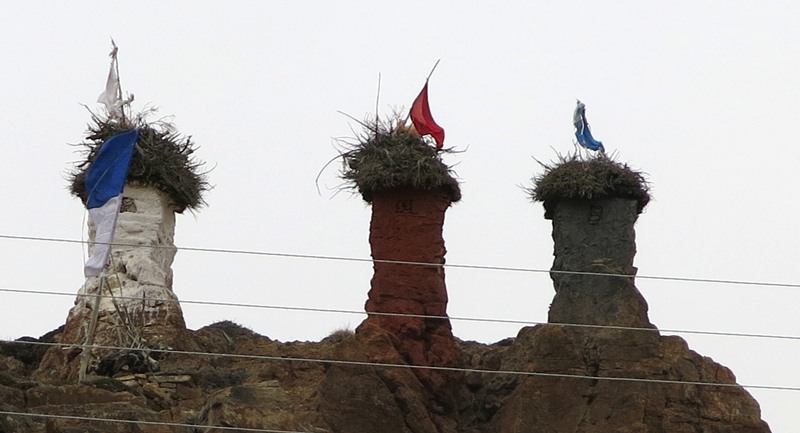
Fig. 7. The Lhathosum, Tashigang.
The spirit-medium of Langdza (Lang-rdza) is Tashi Tshering (bKra-shis tshe-ring, aged fifty-one). The jowa of Langdza is Pema Wangdrak (Padma dbang-grags, in his seventies). He also serves the villages of Hikkim, Gongmik, Demul, Lara, Shego, Kaza and Kwang. I had the opportunity to interview both of these men in Kaza. A famous ancestor of Pema Wangdrak was Jowa Dudpo (Jo-ba bdud-po), so named for his black complexion. He is supposed to have lit ritual fires that magically burned for a year. Tashi Tsering’s father Ngodrup Thubten (Dngos-sgrub thub-bstan) was also the luyar of Langdza. Before that the spirit-mediums of Langdza came from another family, the last of which was Sonam Choephel (bSod-nams chos-’phel). His father was Meme Tsundrup (Mes-mes btsun-sgrub) who died around ninety years of age, some sixty years ago.
The most powerful yulha in Langdza is Pekar Gyalpo (Pe-dkar rgyal-po), a white god also called Buddhist Protector (Chos-skyong). For possession by Pekar Gyalpo, Tashi Tshering wears a white dress and a copper alloy mirror over the chest. The second most powerful yulha in Langdza is (Tsiu Marpo (rTsi’u dmar-po), the king of 360 fierce red spirits (btsan), the chief (gtso-bo) of the powerful brotherhood of seven red spirits known as Barwa Pündun (’Bar-ba spun-bdun), and the minister (blon-po) of the eight classes of worldly spirits in Tibetan Buddhism (lha-srin sde-brgyad). When Tsiu Marpo is the object of possession, Tashi Tshering wears a red dress and a ritual mirror on his chest and back. He comments that Tsiu Marpo is particularly effective in treating paralysis and vertigo. It is believed that long ago Tsiu Marpo was fastidiously worshipped (sku-rim) in order to get him to reside in Langdza.
The female yulha of Langdza is Sring-mo or Achi Akardzati (A-phyi A-dkar dza-ti). She winters in the Kullu valley. She returns to Langdza in the 2nd lunar month. She is in the retinue of the Sakya protective deity Gurgön (Gur-mgon), the guardian of Tengyü (sTeng-rgyud) monastery. In addition to treating disease, she grants long life and is specially propitiated by childless women.
A fourth yulha of Langdza is Kasung (Bka’-srung), a giver of medicine and and special patron of the village. He belongs to the ‘a man dies a spirit is born’ (mi-shis btsan-skyes) class of Buddhist deities, which became increasingly popular in Tibet after the 11th century CE. According to Tashi Tshering and Pema Wangdrak, there was once a lama in Spiti who was a great Buddhist practitioner. When he became ill, he donated almost all of his considerable wealth to Tengyü monastery, except for his drinking bowl, bell and dorje. He planned to give these away too before he died but death overcame him first. Distracted by his unfulfilled wish he lost his way in the intermediate realm and was reborn as a god (lha). Kasung is the only yulha of Langdza to drink alcohol during trance ceremonies.
A Brief Report on the Oldest Residences of Spiti
The residence of Lochen Rinpoche at Key monastery
The oldest residence in Spiti is the personal quarters (gzims-chung) of Lochen Rinpoche at Key (dKyil) monastery. It is said by monks that this apartment is hundreds of years old. Reportedly, its walls are built of mud bricks, but the residence is now encased in other monastic structures. The old quarters are situated directly below the newer residence of Lochen Rinpoche, at the very top of the monastic complex.
Lochen Rinpoche no longer sleeps in his old quarters, but he uses the chapel (lha-khang) there. In addition to this chapel, there is a kitchen (thab-tshang) that now functions as a sort of office. Both the kitchen and chapel have four pillars each. The kitchen has been retrofitted with a larger door and the older small entranceway has been walled up. A window has been added to the kitchen to admit more light. Wooden brackets support roof beams. Some of the woodwork in the kitchen and chapel is made of juniper. The small doorway between the kitchen and chapel is still intact.
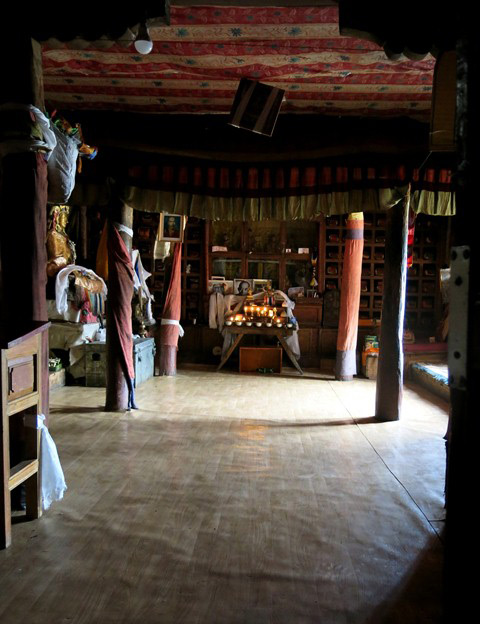
Fig. 8. The chapel in the old residence of Lochen Rinpoche, Key monastery.
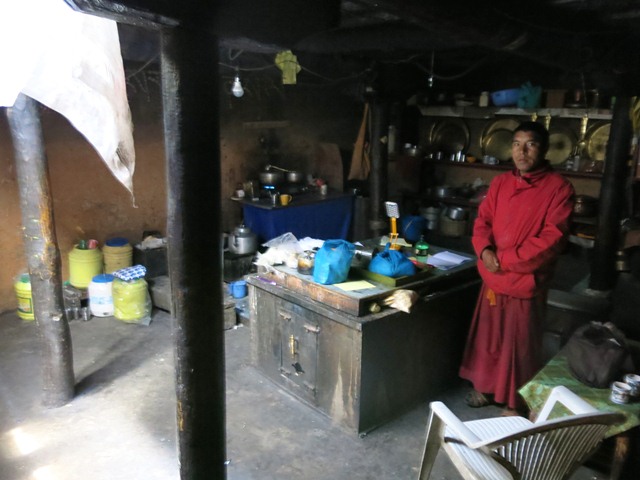
Fig. 9. The old kitchen of Lochen Rinpoche, Key monastery.
The Jowa’s Chapel in Tashigang
The small village of Tashigang is clustered on a large lump of rock, giving it a redoubtable aspect. The most ancient traces of habitation are found on a light-colored cliff-face situated beside the village. This cliff is approximately 10 m high. Here on an overhang are faint traces of red ochre applications. Among them are a couple of circular designs can be discerned. At the foot of the cliff on a series of rock terraces are several circular holes that were once used for grinding. Tombs found at Tashigang will be the subject of study in a forthcoming newsletter.
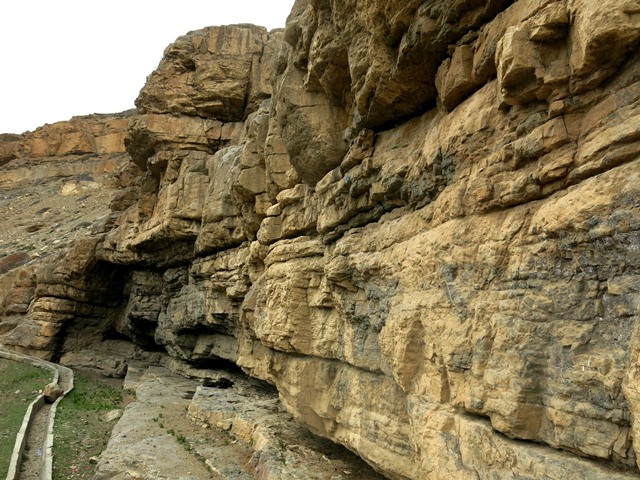
Fig. 10. The cliff at Tashigang, which has signs of ancient habitation.
There is also a derelict residence in Tashigang said to be at least 200 years old. It is believed by the two current jowo of the village to have functioned as the chapel of their distant predecessors. The mud-brick and stone structure consisted of one room with four stout juniper pillars in the middle supporting the roof, almost none of which is still intact. The rafters are mostly of juniper as well. Some rafters still rest upon wooden brackets, an older style of construction in Spiti. It is said that in times of war, the Tashigang jowa would carry out rituals to protect and empower the 250 khangchen families of Spiti.
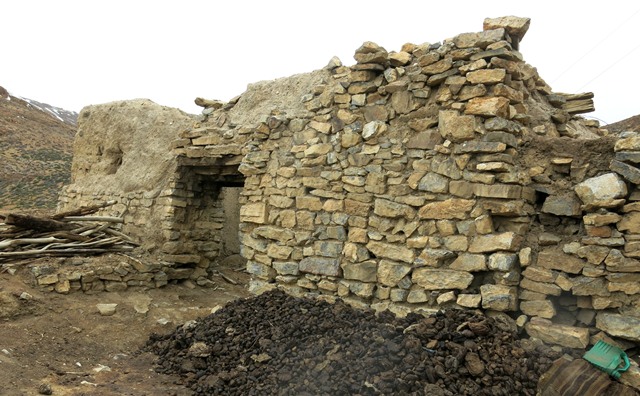
Fig. 11. The east side of the old house of the jowa, Tashigang. The massive east wall is about 1 m thick. Note the composite stone and wooden lintel over the entranceway and the coursed-rubble stonework.
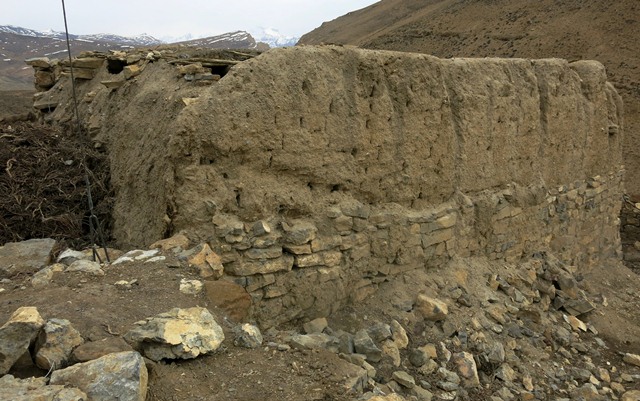
Fig. 12. The west (right) and north (left) walls of the old house of the jowa, Tashigang. Note the highly eroded upper courses of mud bricks. The stonework on this side of the building is not as extensive as on the east face. The wooden rafters of the roof can be seen protruding from the north wall of the structure.
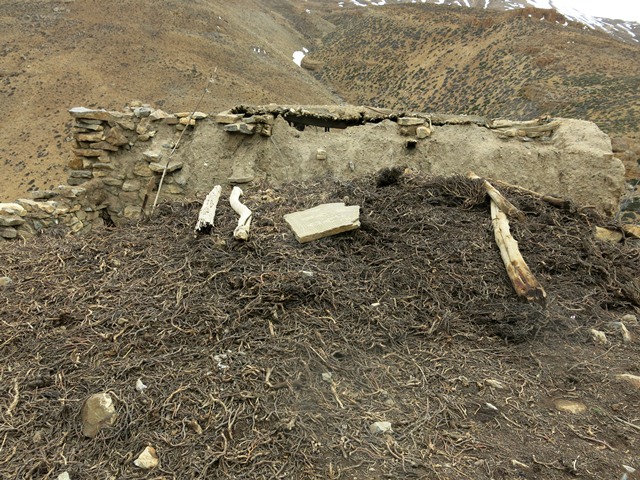
Fig. 13. The north side of the old house of the jowa, Tashigang.
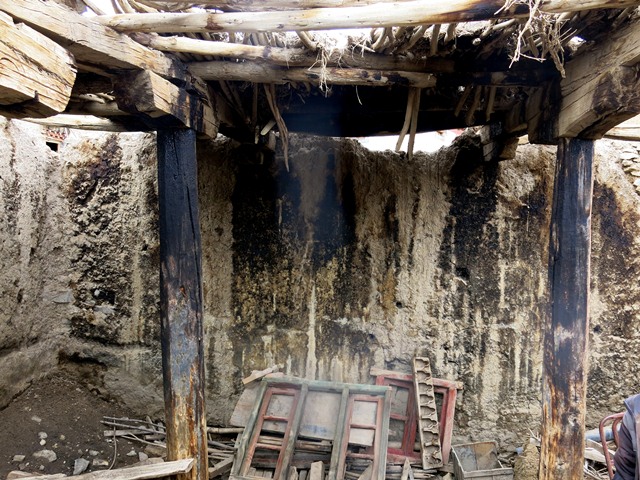
Fig. 14. The interior of the old house of the jowa, Tashigang. Very little of the roof remains intact.
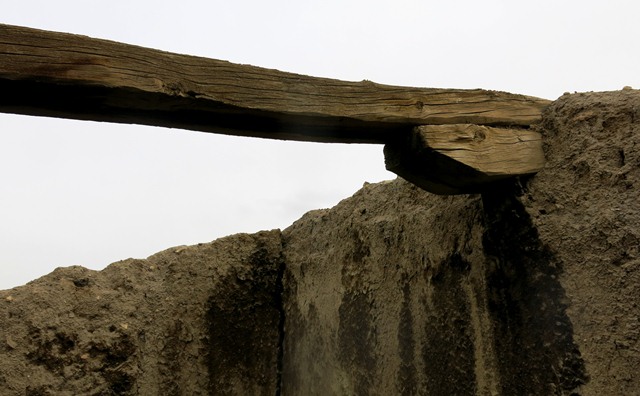
Fig. 15. A rafter and supporting bracket made of juniper in the old house of the jowa, Tashigang.
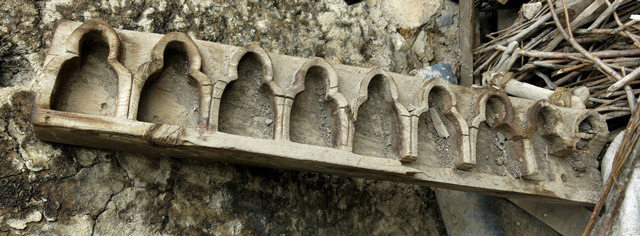
Fig. 16. An altarpiece consisting of nine niches still lying inside the old house of the jowa, Tashigang . Presumably, representations of an ennead of deities were enshrined in this wooden case. What this group of deities might have been is unknown to contemporary residents of Tashigang.
One of the oldest occupied houses in Spiti, Key village
In Spiti it is common to demolish houses after only one or two generations of use. This is especially true in the last half century, as more modern materials such as steel and concrete become available for domestic construction purposes. Thus there are very few old houses still standing anywhere in the region. One of the oldest houses in Spiti is located in Kye (dKyil) village. It is believed to be at least 150 years old.
This house is owned by Tenzin Tshultrim (bsTan-’dzin tshul-khrims, aged thirty-seven), whose children are the sixth generation of the family to occupy it. The father of Tenzin Tshultrim, Dorje Wangchuk (rDo-rje dbang-phyug, aged sixty) also lives in the house. The patriarchs of the three generations before him who also resided there were Tashi Gyaltsen (bKra-shis rgyal-mtshan), Dondrup Choephe (Don-grub chos-’phel) and Tsheten Dondrup (Tshe-brtan don-grub). In order to encourage others to save the few old houses left in Spiti, the family of Tenzin Tshultrim kindly allowed me to photograph it inside and out.
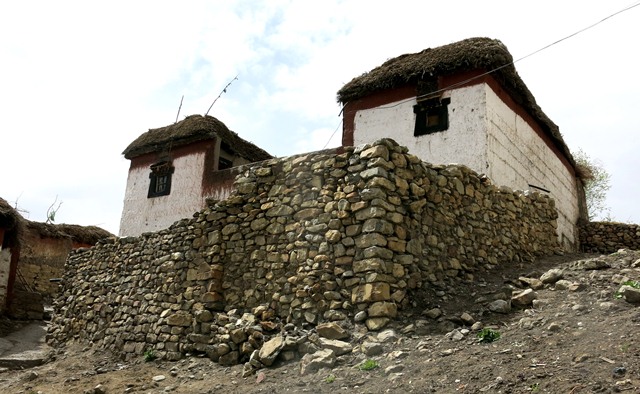
Fig. 17. The south and east sides of the Tenzin Tsultrim residence, Key village. The high walls in front of the house enclose a courtyard where sundry domestic functions take place.
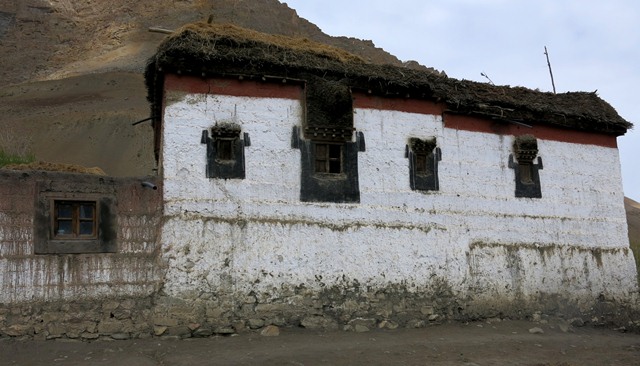
Fig. 18. The north side of the Tenzin Tsultrim residence, Key. Note the different-sized windows, each with complex denate lentils. Above the band of red ochre is a tamarisk cornice and above that brush is stacked on the roofline.
The residence of Tenzin Tshultrim is clean, neat and welcoming.* Its architecture is typical of houses built in Spiti by major landowning households (khang-chen) in the second half of the 19th century.† It is a two-story, south-facing structure with an almost square plan. Its walls are aligned in the cardinal directions. The house is built into a hillside, giving it a semi-subterranean aspect. The lower courses of the walls of the first floor are made of stone upon which rest mud-brick walls. There is a patio in the middle of the second story of the house surrounded by rooms on three sides. All entranceways of the Tenzin Tshultrim residence are around 1.3 m in height, much lower than in modern buildings. The house has a few small windows on the second level but the first level is windowless (a skylight has been installed recently).
In a 19th century description of a zamindar’s house in Spiti, Harcourt (1871: 48, 49) also described it as clean and tidy. Khosla (1979: 109) describes and provides a plan of a house he states is typical in Spiti. However, the layout of this house bears little resemblance to the Tenzin Tsultrim residence, illustrating how domestic architecture had changed over the century before Khosla wrote his account. In the house described by Khosla, there are no livestock stalls or areas for the storage of fodder.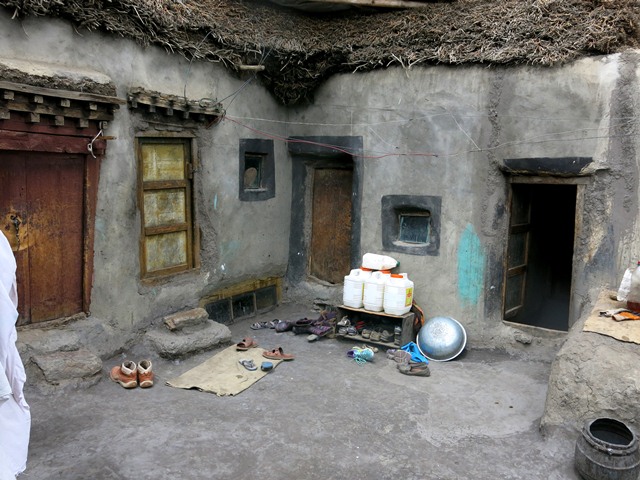
Fig. 19. The patio on the second floor of the Tenzin Tsultrim house. The entranceway to the patio is on the extreme right. The middle right door leads to a small sleeping room. The middle left door accesses the new summer kitchen and the large doorway on the extreme left is the old summer kitchen.
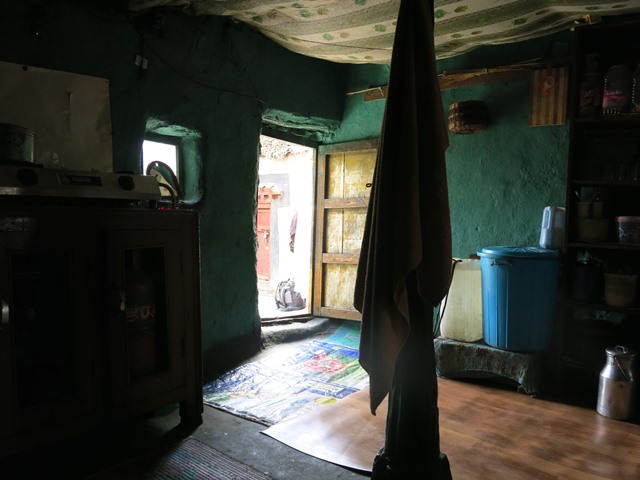
Fig. 20. The interior of the current summer kitchen, Tenzin Tsultrim house.
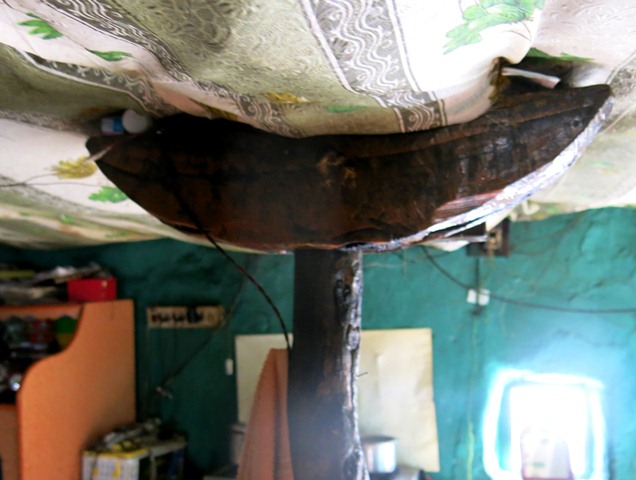
Fig. 21. An old capital of juniper in the summer kitchen, Tenzin Tsultrim house. This room was retrofitted with windows.
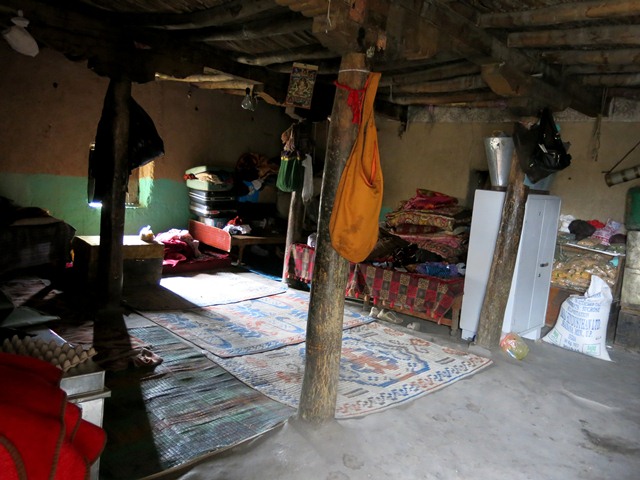
Fig. 22. The old summer kitchen, Tenzin Tsultrim house.
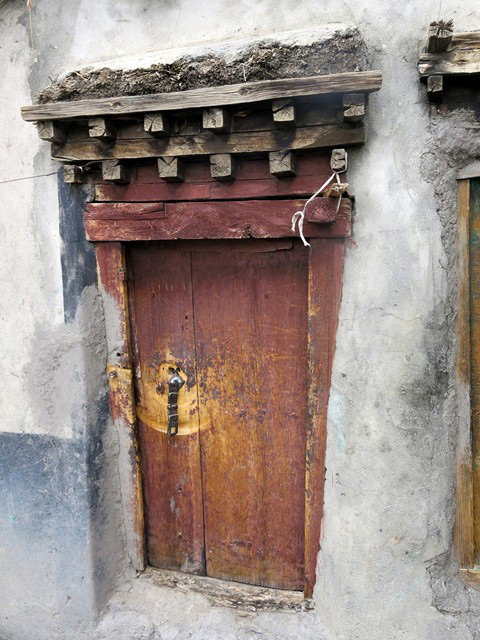
Fig. 23. The doorway to the family chapel, Tenzin Tsultrim house.
Surrounding the patio of the second floor is the summer kitchen (ma-khang; north side of house), family chapel (chos-khang; southwest), large storage room with four pillars that originally served as the summer kitchen (north, situated west of current kitchen), small sleeping area (gzims-chung; northeast), latrine and landing (both on southeast side of house).
A flight of stone steps (southeast) provides accesses the ground floor and main entranceway of the house (in middle of the south wall). The first floor is bisected by an axial corridor that runs east to west. There is a room for the storage of fodder (rtswa-khang; northeast), food preparation area for livestock (bi-thug; southeast), storage room (central south), winter kitchen with four pillars (ma-khang; central north), five chambers for livestock (ra; northwest), dung storage space (lci-ba khang; southwest),* and four or five stalls for sheep and goats (lug-ra; west).†
On the nomenclature and usages of yak dung in Spiti, see Tashi Tsering 2014, pp. [n. 159], 206. Harcourt (1871: 103) describes a Spitian residence of three floors, which has many similarities to the Tenzin Tshultrim residence. The following description is derived from his work. The first three or four feet of the walls are built of stone, the remainder is composed of mud bricks. Solid beams run the length of rooms with willow and juniper making up the interlinking materials. There are no chimneys and the ceilings assume a deep coal hue. Below the roof there is a band of red. Houses have low doorways, stone steps, small windows with wooden shutters and commodious stalls for cattle. Harcourt (ibid.) adds that tamarisk twigs are placed above the ceiling. This forms a structurally functional cornice. According to Tashi Tsering (2014: 207), this cornice is called penchar (spen-’phyar). Diack (1899: 79) also notes that the upper level of Spitian houses is open on three sides, and that the ground floor contains a winter room for the family, livestock stalls and areas for the storage of fodder. Tucci (1936: 154, 155) observes that the plan and appearance of houses in Spiti is similar to those in Lug, in Guge.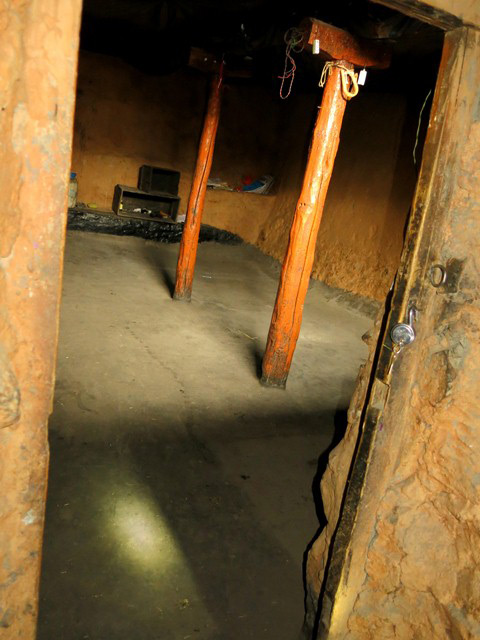
Fig. 25. The old winter kitchen, Tenzin Tsultrim house.
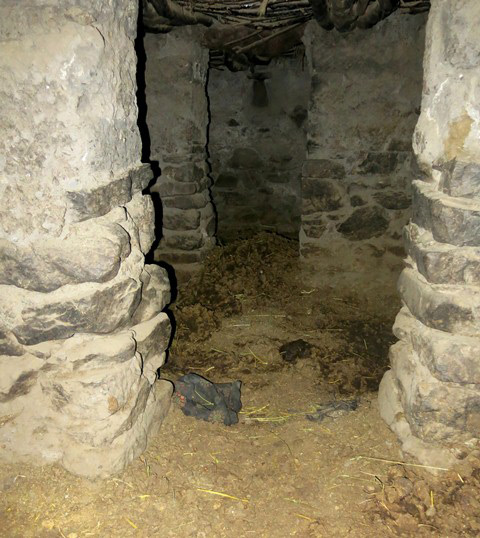
Fig. 26. Livestock stalls, Tenzin Tsultrim house.
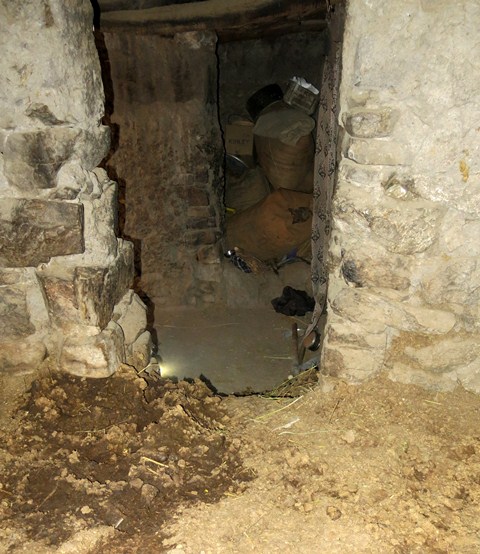
Fig. 27. Storage room on ground floor, Tenzin Tsultrim house.
Few modern houses have either a semi-subterranean aspect or an open-air space on the second floor. Underground living is no longer preferred, despite winter kitchens being easy to keep warm. Also, modern Spitians do not like to live in close proximity to their livestock. The collected wood and brush laid out on the four sides of the roof (shing-spe) helps protect mud houses from excessive rain (cf. Tashi Tsering: 2014: 207). This architectural feature is still prevalent in Spiti.
Bibliography for the May and June Newsletters
Flight of the Khyung newsletters (by John Vincent Bellezza, unless otherwise noted)
2015, January. “More Ancient Khyung in the Rock Art of Upper Tibet”.
http://www.tibetarchaeology.com/january-2015/
2014, January. “Tigers is ancient western Tibet: More evidence”.
http://www.tibetarchaeology.com/january-2014/
2013, August. “Tibetan turquoise: Beaming stone of life;” “Antique Tibetan and Chinese Turquoise”, text and photographs by James Wainwright; “Notes and Addendum on: Tibetan Turquoise: Beaming stone of life”, text and photographs by Stephen Shucart; “Excerpt from an article pertaining to turquoise”, by Samten G. Karmay.
http://www.tibetarchaeology.com/august-2013/
2013, June. “Gyapa Jo Khar of Nyarma; Gyapa Jo Khar and the historical signification of the term Zhang Zhung”.
http://www.tibetarchaeology.com/june-2013/
2013, January. “High on the khyung”.
http://www.tibetarchaeology.com/january-2013/
2012, January. “The Horned Eagle: Tibet’s greatest ancestral and religious symbol across the ages”.
http://www.tibetarchaeology.com/january-2012/
All other works
Bajpai, S. C. 1987. Lahaul-Spiti: A forbidden land in the Himalayas. New Delhi: Indus Publishing Company.
Balikci, Anna. 2008. Lamas, Shamans and Ancestors: Village Religion in Sikkim. Brill’s Tibetan Studies Library, vol. 17. Leiden: Brill.
Bellezza, John Vincent. In press. “The Voice of the Gods in Upper Tibet: The trance-induced invocations and songs of praise of the spirit-medium Phowo Sridgyal” in Festschrift dedicated to Per K. Sørensen on the occasion of his 65th birthday. Institut für Indologie und Zentralasienwissenschaften, University of Leipzig.
____2014a. The Dawn of Tibet: The Ancient Civilization on the Roof of the World. Lanham: Rowman & Littlefield.
____2014b. “Straddling the Millennial Divide: A case study of persistence and change in the Tibetan ritual tradition based on the Gnag rabs of Gathang Bumpa and Eternal Bon documents, circa 900–1100 CE”, in Revue d’etudes tibétaines, vol. 29, pp. 155–243. Paris: CNRS.
http://himalaya.socanth.cam.ac.uk/collections/journals/ret/pdf/ret_29_07.pdf
____2013. Death and Beyond in Ancient Tibet: Archaic Concepts and Practices in a Thousand-Year-Old Illuminated Funerary Manuscript and Old Tibetan Funerary Documents of Gathang Bumpa and Dunhuang. Philosophisch-Historische Klasse Denkschriften, vol. 454. Wien: Verlag der Österreichischen Akademie der Wissenschaften.
____2012. “Spirit-mediumship in Upper Tibet: The Vocation of one expert practitioner” in Bulletin of Tibetology, vol. 48, no. 2, pp. 7–32. Gangtok: Namgyal Institute of Tibetology. 2011: in Exploring Tibet’s History and Culture. Proceedings of the International Conference held in New Delhi, 2009 (ed. P. Roy), pp. 379–410. Samyak Vak Series, vol. 17. Varanasi: Central University of Tibetan Studies.
____2011a. “Territorial Characteristics of the Pre-Buddhist Zhang-zhung Paleocultural Entity: A Comparative Analysis of Archaeological Evidence and Popular Bon Literary Sources”, in Emerging Bon: The Formation of Bon Traditions in Tibet at the Turn of the First Millennium AD (ed. H. Blezer), pp. 51–116. PIATS 2006:Proceedings of the Eleventh Seminar of the International Association for Tibetan Studies, Königswinter 2006. Halle: International Institute for Tibetan and Buddhist Studies GmbH.
____2011b. “The liturgies and oracular utterances of the spirit-mediums of Upper Tibet: An Introduction to their bSang Rituals” in Revue d’etudes tibétaines, no. 20, pp. 5–31. Paris: CNRS. http://www.himalaya.socanth.cam.ac.uk/collections/journals/ret/pdf/ret_20_01.pdf.
____2008. Zhang Zhung: Foundations of Civilization in Tibet. A Historical and Ethnoarchaeological Study of the Monuments, Rock Art, Texts and Oral Tradition of the Ancient Tibetan Upland, Philosophisch-Historische Klasse Denkschriften, vol. 368. Wien: Verlag der Österreichischen Akademie der Wissenschaften.
____2005. Calling Down the Gods: Spirit-Mediums, Sacred Mountains and Related Bon Textual Traditions in Upper Tibet, Tibetan Studies Library, vol. 8,Leiden: Brill.
____2001. Antiquities of Northern Tibet: Archaeological Discoveries on the High Plateau, Delhi: Adroit.
Dagkar, Namgyal Nyima. 1999. “gShen: The Ancestral Clan of Rin chen bzang po”, in The Tibet Journal, vol. 24 (no. 2), pp. 46–59. Dharamsala: Library of Tibetan Works and Archives.
Das, Sarat, Chandra. 1902. Tibetan-English Dictionary (Tshig gi gter mdzod). Reprint, Delhi: Motilal Banarsidass, 1998.
De Rossi Filibeck, Elena. 2002. “A Description of Spyi ti by J. Gergan”, in Territory and Identity in Tibet and the Himalayas. PIATS 2000: Tibetan Studies: Proceedings of the Ninth Seminar of the International Association for Tibetan Studies, Leiden 2000. Brill’s Tibetan Studies Library, vol. 2/9. Leiden: Brill.
Diack, A. H. 1899. Gazetter of the Kangra District. Parts II to IV. Kulu, Lahul and Spiti 1897. Reprint, Delhi: B. R. Publishing Corporation.
Diemberger, Hildegard. 1992. “Lovanga [Lo ’bangs pa?] Lama and Lhaven [Lha bon]: Historical Background, Syncretism and Social relevance of Religious Tradition among the Khumbo (East Nepal)”, in Tibetan Studies: Proceedings of the 5th Seminar of the International Association of Tibetan Studies Narita, 1989 (eds. S. Ihara and Z. Yamaguchi), pp. 421–433). Narita: Naritan Shingshoji.
Diemberger, Hildegard and Hazod, Guntram. 1997. “Animal sacrifices and mountain deities in southern Tibet”, in Les habitants du toit du monde (eds. S. Karmay and Ph. Sagant), pp. 261–282. Nanterre: Société d’Ethnologie.
Dorji, Tamdin. 2002. “The Lha ’bod: An Invocation Ritual in Sbe nag (Western Bhutan)”, in Territory and Identity in Tibet and the Himalayas. PIATS 2000: Tibetan Studies: Proceedings of the Ninth Seminar of the International Association for Tibetan Studies, Leiden 2000. Brill’s Tibetan Studies Library, vol. 2/9. Leiden: Brill.
Dotson, B. 2009. The Old Tibetan Annals. An Annotated Translation of Tibet’s First History. Philosophisch-Historische Klasse Denkschriften, vol. 381. Wien: Verlag der Österreichischen Akademie der Wissenschaften.
Egerton, Philip Henry. 1864. Journal of a Tour Through Spiti to the Frontier of Chinese Thibet. Reprint, Bath: Pagoda Tree Press, 2011.
Francke, A. H. 1914. Antiquities of Indian Tibet. Part 1, Personal Narrative. Reprint, Delhi: Archaeological Survey of India, New Imperial Series, vol. 38., S. Chand, 1994.
Gergan, S. S. 1978. “The Lo-sar of Ladakh, Spiti, Lahul, Khunnu and Western Tibet”, in The Tibet Journal, vol. 3 (no. 3), pp. 41–43. Dharamsala: LTWA.
Gu-ge tshe-ring rgyal-po. 2005. Gu ge tshe ring rgyal po’i ched rtsom phyogs bsgrigs. Lhasa: Krung-go’i bod rig-pa dpe-skrun khang.
Gurung, B. C. 2003. Bon in the Himalaya. Kathmandu: Uma Gurung.
Haarh, Erik. 1968. “The Zhang-Zhung Language: A Grammar and Dictionary of the Unexplored Language of the Tibetan Bonpos”, in Acta Jutlandica, Skrifter fra Aarhus Universitet, XL, 1. København: Einar Munksgaard.
Handa, O. C. 2001. Buddhist Western Himalaya. Part 1 – A Politico-Religious History. New Delhi: Indus Publishing House.
____1994. “Role of Rin-chen-bZang-po in the development of Buddhism”, in Proceedings of the National Seminar on Preservation and Development of Himalaya Culture, pp. 1–15. Kyelong: Richen Zangpo Culture & Literary Society.
Harcourt, A. F. P. 1871. The Himalayan Districts of Kooloo, Lahoul and Spiti. Reprint, Delhi: Vivek Publishing House, 1972.
Hein, Veronika. 2007. “A Preliminary Analysis of Some Songs in Tibetan Language Recorded in Spiti and Upper Kinnaur”, in Text, Image and Song in Transdisciplinary Dialogue (eds. D. Klimburg Salter et al.), pp. 235–247. PIATS 2003: Tibetan Studies: Proceedings of the Tenth Seminar of the International Association for Tibetan Studies, Oxford, 2003. Brill’s Tibetan Studies Library, vol. 10/7. Leiden: Brill.
Hoffman, H. 1961. The Religions of Tibet (trans. E. Fitzgerald). London: George Allen & Unwin.
Hutchinson, J. and Vogel, J. Ph. 1933. History of Kangra and Kulu States. Reprint, New Delhi: Northern Book Centre, 1986.
Jahoda, Christian. 2009. Mountains, Monasteries and Mosques: Recent Research on Ladakh and the Western Himalaya (eds. J. Bray and E. R. Filibeck), pp. 46–58. Proceedings of the 13th Colloquium of the International Association of Ladakh Studies. Rome: Sapienza, Università di Roma, Dipartimento di Studi Orientali.
Kapadia, H. 1999. Spiti: Adventures in the trans-Himalaya. New Delhi: Indus Publishing Company.
Karmay, Samten G. 2014. The Arrow and the Spindle: Studies in History, Myths, Rituals and Beliefs in Tibet, vol. 3. Kathmandu: Mandala Book Point.
Khosla, Romi. 1979. Buddhist Monasteries in the Western Himalaya. Kathmandu: Ratna Pustak Bhandar.
Klimburg-Salter, Deborah. 1997. Tabo: A Lamp for the Kingdom. Early Indo-Tibetan Buddhist Art in the Western Himalaya. Milan: Skira Editore.
Laurent, Lobsang Nyima. 2014. “The Upper Temple of Dangkhar Monastery: Iconographical Capharnaüm or Political Manœuvre?”, in Revue d’Etudes Tibétaines, no. 29, Avril 2014, pp. 103-153. Paris: CNRS. http://himalaya.socanth.cam.ac.uk/collections/journals/ret/pdf/ret_29_06.pdf
____2011. “More Historical Research on Brag Mkhar”, in The Ancient Monastery Complex at Dangkhar. Research and Restoration Project – Annual Report 2011, pp. 124–136. Graz: Graz University of Technology, Faculty of Architecture, Institute of Architectural Theory, Art History and Cultural Studies.
http://www.savedangkhar.tugraz.at/pdfs/2011/07_more%20historical%20research_hp.pdf
____2010. “The Fortress Monastery of Brang Mkhar: An Anamnesis”, in Save Dangkhar, Annual Report 2010, pp. 7–14. Graz: Graz University of Technology, Faculty of Architecture, Institute of Architectural Theory, Art History and Cultural Studies.
http://savedangkhar.tugraz.at/pdfs/2010/the%20fortress-monastery%20of%20brag%20mkhar.pdf
Martin, D. 2010. “Zhangzhung Dictionary” in Revue d’Etudes Tibétaines, No. 18, April, 2010, pp. 33–253. Paris: CNRS. http://himalaya/socanth.cam.ac.uk/collections/journals/ret/pdf/ret_18_02.pdf
Mumford, Stan Royal. 1990. Himalayan Dialogue: Tibetan Lamas and Gurung Shamans in Nepal. Kathmandu: Tiwari’s Pilgrims Book House.
Nebesky-Wojkowitz, Réne. De. 1956. Oracles and Demons of Tibet. The Cult and Iconography of the Tibetan Protective Deities. Reprint, Kathmandu: Tiwari’s Pilgrims Book House, 1993.
Negi, T. S. 2000. “Glossary of Words”, in Lahaul-Spiti: Forbidden Land in the Himalayas, by S. C. Bajpai, pp. 143–152. New Delhi: Indus Publishing Company.
Orofino, Giacomella. 1990. “A Note on Some Tibetan Petroglyphs of the Ladakh Area”, in East and West, vol. 40 (nos. 1–4), pp. 173–200. Rome: Istituto Italiano Per il Medio ed Estremo Oriente.
Petech, Luciano. 1997. “Western Tibet: Historical Introduction”, in Klimburg-Salter’s Tabo: A Lamp for the Kingdom. Early Indo-Tibetan Buddhist Art in the Western Himalaya, pp. 229–251. Milan: Skira Editore.
____1977. The Kingdom of Ladakh. C. 950-1842 A.D. Oriental Series, vol. 51. Rome: IsMEO.
Rahula. 2013. An Ancient Western Himalayan Repository of Age – Old Indian and Tibetan Mural Paintings and Scripts Dating from the Tenth to Twentieth Century (Ta po: Dus rabs bcu pa nas nyi shu pa’i bar gyi snga mo’i rgya gar dang bod kyi ldebs ris dang yi ge nub Hi ma’ la ya’i gna’ bo’i dgon grang zhig). Tabo: Ta-po dgon gyi dpe-mdzod khang.
Ramble, Charles. 2007. “The Aya: fragments of an unknown Tibetan priesthood”, in Pramāṇakīrtiḥ. Papers Dedicated to Ernst Steinkellner on the Occasion of his 70th Birthday. Part 2 (eds. B. Kellner, et al.), pp. 681–718. Wien: Wiener Studien zur Tibetologie und Buddhismuskunde.
Richardson, H. E. 1998. High Peaks, Pure Earth. Collected Writings on Tibetan History and Culture. London: Serindia Publications.
____1967. “Names and titles in early Tibetan records”, in Bulletin of Tibetology vol. 4 (no. 1), pp. 5–20.
http://himalaya.socanth.cam.ac.uk/collections/journals/bot/pdf/bot_1985_03_01.pdf
Shastri, Lobsang. 2007. “Ri bo’i gangs can pa’i rtsom rig nang spi ti dang ta po’i skor”, in gTam tshogs / Bod ’brel shes yon go rtogs gong spel ched, vol. 27 (no. 2), pp. 33–72. Dharamsala: LTWA.
Snellgrove, David L. 1957. Buddhist Himālaya: Travels and Studies in quest of the origin and nature of Tibetan Religion. Oxford: Bruno Cassirer.
Snellgrove, David L. and Skorupski, Tadeusz (with Phillip Denwood). 1980. The Cultural Heritage of Ladakh. Vol 2: Zangskar and the Cave Temples of Ladakh. Warminster: Aris and Phillips.
Stein, R. A. 2010 Rolf Stein’s Tibetica Antiqua (trans. & ed. A. P. McKeowen). Brill’s Tibetan Studies Library, vol. 24. Leiden: Brill.
____1972. Tibetan Civilization (trans. J. E. S. Driver). Stanford: Stanford University Press.
____ “1971. “La langue Źhang-źung du Bon organisé”, in Bulletin De l’Ècole Française D’Extrême Orient, vol. 58, pp. 231–254. Paris.
Sutherland, Patrick and Tsering, Tashi. 2011. Disciples of a Crazy Saint: The Buchen of Spiti. Oxford: Pitt Rivers Museum.
Tashi Tsering. 2014. “Social Inequality and Resource Management: Gender caste and Class in the Rural Himalayas” Ph.D. dissertation, University of British Columbia.
____2013. “On the Unknown History of a Himalayan Buddhist Enclave: Spiti Valley before the 10th Century”, in Current Issues and Progress in Tibetan Studies (eds. T. Takeuchi, et al.). Proceedings of the Third International Seminar of Young Tibetologists, Kobe 2012. Kobe: Research Institute of Foreign Studies, Kobe City University of Foreign Studies.
Tashi Tsering and Ishimura, Gaku. 2012. “A Historical Overview of Education and Social Change in Spiti valley, India”, in International Association of Ladakh Studies, Ladakh Studies, vol. 28, pp. 4–16 (ed. K. Gutschow).
Thakur, Laxman, S. 2001. Buddhism in the Western Himalaya: A Study of Tabo Monastery. Delhi: Oxford University Press.
Thukral, K. (2006). Spiti: Through Lore and Legend. New Delhi: Mosaic Books.
Tobdan. 2015a. A Grammar of sTodpa. A Language of Lahul in the Western Himalaya. Kaithal: Amrit Books.
____2015b. Spiti: A Study in Socio-Cultural Traditions. New Delhi: Kaveri Books.
Tropper, Kurt. 2008. The Founding Inscription in the gSer khang of Lalung (Spiti, Himachal Pradesh). Dharamsala: LTWA.
Tucci, Giuseppe. 1988. Rin-chen-bzang-po and the Renaissance of Buddhism in Tibet around the Millennium. Śata-Pițaka Series, Indo-Asian Literatures, vol. 348 (trans. N. Kipp Smith) (an English version of Indo-Tibetica II). New Delhi: Aditya Prakashan.
____1966. Tibetan Folk Songs from Gyantse and Western Tibet. With two appendices by Namkhai Norbu. Ascona: Artibus Asiae.
____(in collaboration with Capt. E. Ghersi). 1936. Shrines of a Thousand Buddhas: Exploring for Tibet’s Hidden Art. New York: Robert M. McBride & Co. Reprint, Varanasi: Pilgrims, 2008.
van Driem, George. 2001. Languages of the Himalayas: An Ethnolinguistic Handbook of the Greater Himalayan Region. Leiden: Brill.
____2001b. “Zhangzhung and its next of kin in the Himalayas”, in New Research on Zhangzhung and Related Himalayan Languages. Bon Studies 3 (eds. Y. Nagano and R. J. LaPolla), pp. 31–44. Osaka: National Museum of Ethnology.
Vitali, Roberto. 2000. A Short Guide to Key Gonpa. Key Monastery.
____1996. The Kingdoms of Gu.ge Pu.hrang. According to mNga’.ris rgyal.rabs by Gu.ge mkhan.chen Ngag.dbang grags.pa. Dharamsala: Tho.ling gtsug.lag.khang lo.gcig.stong ’khor.ba’i rjes.dran.mdzad sgo’i go.sgrig tshogs.chung.
Zeisler, Bettina. 2009-2010. “East of the Moon and West of the Sun? Approaches to a Land with Many Names, North of Ancient India and South of Khotan. in The Tibet Journal, vol. 34 (no. 3) to vol. 35 (no. 2), pp. 371–463. Dharamsala: LTWA.
Next Month: Spiti and its prehistoric cultural links to Upper Tibet!
